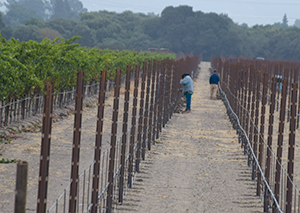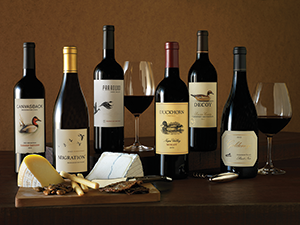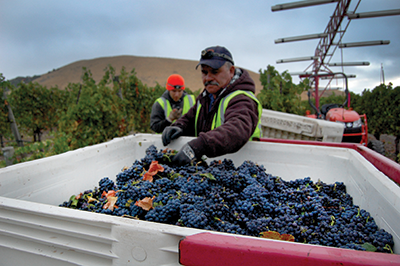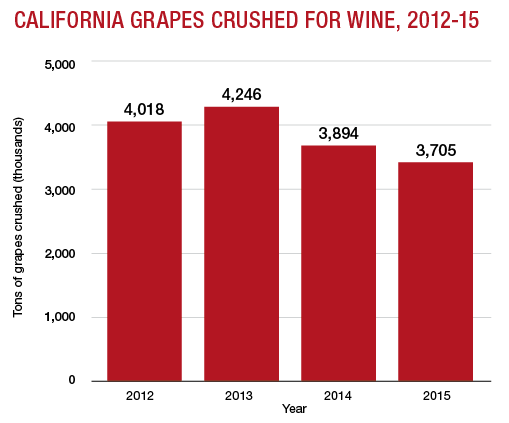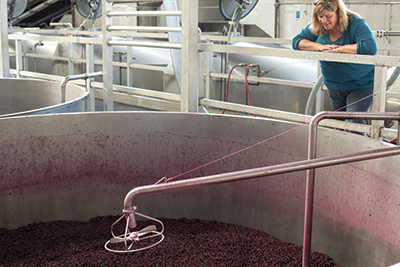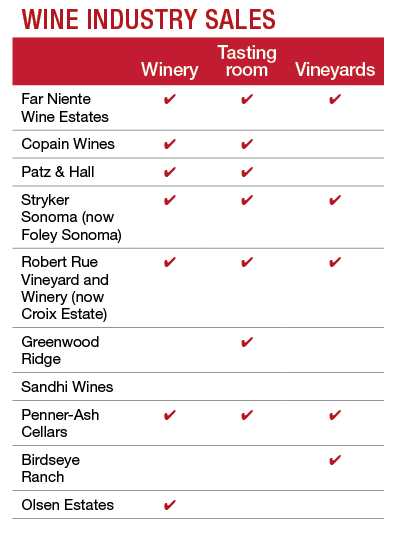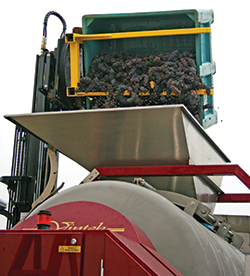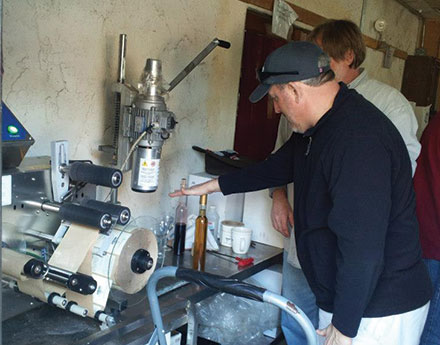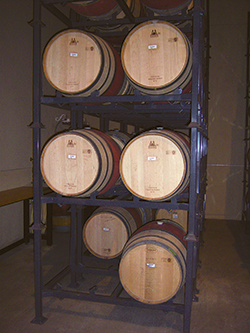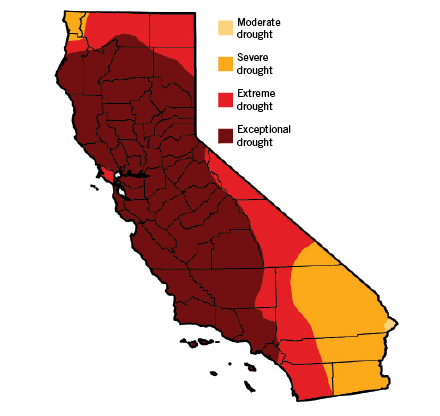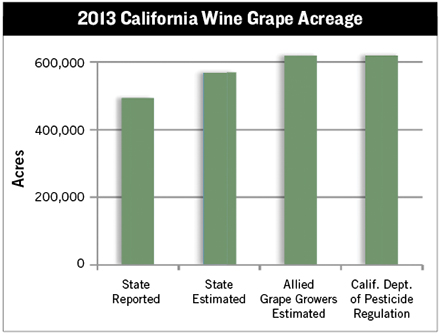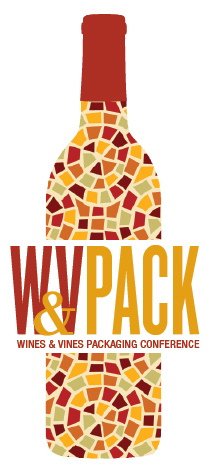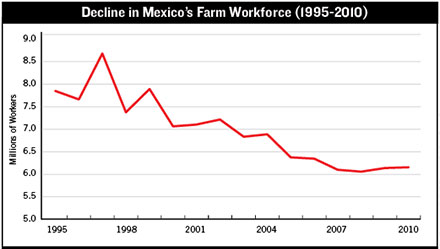
Top Stories
by Andrew Adams, Jaime Lewis, Jane Firstenfeld and Kate LavinTop Stories
January 2018Fiery End to 2017 for California
San Rafael, Calif.—Firefighters were slowly gaining containment on a massive fire in Santa Barbara and Ventura counties as Wines & Vines went to print in mid-December.
READ MORE »
Top Stories
January 2018Researchers: Clean Sites and Vines Are Part of Sustainability
Ottawa, Ontario—Canada’s interprovincial trade laws went to the country’s Supreme Court last month for a hearing vintners hope will finally get wine flowing between provinces without interference from the country’s 13 provincial and territorial liquor boards.
READ MORE »
Top Stories
January 2018Fire Relief Donations Continue from Wineries, Industry Suppliers
Napa, Calif.—Wine companies continue to donate money to assist the victims of the Northern California wildfires started in October. Duckhorn Wine Co. donated $300,000 to Habitat for Humanity of Sonoma County; Gloria Ferrer Caves & Vineyards donated $50,000 to the Redwood Credit Union North Bay Fire Relief Fund; Truett Hurst raised $16,400; Fantesca Estate & Winery donated $10,000, and Free Flow Wines and Luna Vineyards raised $8,000 for the Napa Valley Community Foundation.
READ MORE »
Top Stories
January 2018Canada's Wine Shipping Laws Go to Court
Ottawa, Ontario—Canada’s interprovincial trade laws went to the country’s Supreme Court last month for a hearing vintners hope will finally get wine flowing between provinces without interference from the country’s 13 provincial and territorial liquor boards.
READ MORE »
Top Stories
January 2018Jackson Family Vineyard Manager Says Mechanization Imminent
San Luis Obispo, Calif.—As the labor shortage continues and demand for high-quality wines rises, the need for mechanization in the vineyard is critical and inevitable, Bart Haycraft, vineyard manager for Jackson Family Wines, said recently at the Sustainable Ag Expo in San Luis Obispo. The event is hosted by the Vineyard Team.
READ MORE »
Top Stories
January 2018Cabernet Sauvignon Overtakes Riesling in Washington State
Seattle, Wash.—Cabernet Sauvignon has dethroned Riesling in Washington state, according to the latest vineyard census the USDA’s National Agricultural Statistics Service conducted of vineyards of an acre or more.
READ MORE »
Top Stories
December 2017Don't Count Amazon Out of Wine Game Yet
San Rafael, Calif.—When Amazon sent an email in October letting wineries know it was planning to shutter its online wine marketplace, it triggered headlines announcing the online retail giant was giving up on the wine business for a third time. But it may be premature to say the online retailer is out of the wine business. In fact, Amazon may now be poised to become a truly disruptive force in the North American wine market.
READ MORE »
Top Stories
December 2017Wine Country Tourism Picks Up After Fires
North Coast, Calif.—Media reporting and images may have left many with the impression that Sonoma and Napa wine country was laid to waste by October firestorms, but only weeks later, a different picture emerged. Tourists returned to hotels and tasting rooms, welcomed by staff eager to see business return to normal.
“We were profoundly affected in terms of traffic,” Christopher O’Gorman, director of communications for Rodney Strong Wine Estates, told Wines & Vines. The winery’s vineyards were unscathed, and 95% of the fruit was already harvested, but the winemaker’s house was destroyed in the blaze.
O’Gorman provided some tasting room statistics for the popular 900,000-case destination next to Highway 101 in Windsor, Calif.
The weekend prior to the fires, some 600 people visited. The winery closed Oct. 10-11; when it reopened Oct. 12 (a Thursday), 62 people came in. The first full weekend the fires were contained, Rodney Strong recorded 260 visitors.
Kosta-Browne Wines in Sebastopol, Calif., is open by appointment. The 18,000-case winery and vineyards remain intact. Still, deep loss remains: Co-founder Dan Kosta’s home in Santa Rosa was destroyed, and he’s now living in a fifth-wheel trailer near the winery.
Normally welcoming only one or two groups on weekend days, the fires didn’t change sales much, Kosta said, although some people did cancel their scheduled trips: Traffic was impassible while residents evacuated and emergency responders arrived.
Up to $38 million in tasting room losses
READ MORE »
Top Stories
December 2017Fire Recovery Begins; Demand for Flash Wine Treatment Strong
Napa, Calif.—CalFire declared the North Coast wildfires contained in late October, leaving wine grape growers in Napa County and elsewhere to take account of how the blazes affected their vines and properties.
Although few vineyards burned during the fires, growers had to deal with debris cleanup, repairing damaged infrastructure such as melted irrigation lines and preparing for winter rains.
A crowd of more than 100 people attended a recent Napa Valley Vineyard Technical Group session that focused on wildfire recovery and included presentations by a series of experts.
Andrew McElrone, a plant physiologist with the United States Department of Agriculture at the University of California, Davis, said growers can look for internal damage by making a small cut in the trunk of a vine similar to the type of cut for T-budding and inspecting the interior tissue. Healthy tissue is moist and creamy white in appearance, while dead tissue would be brown and dry.
Land-use consultant Phil Blake, who previously worked for more than 30 years with the USDA National Resource Conservation Service, said growers should reinforce gullies and ephemeral streams with straw bale dikes, weirs and fiber rolls to slow down runoff and capture sediment and ash.
He said one should expect at least double the amount of storm runoff, and in heavy storms it could be two to three times what’s normal. Farm ponds may need to be protected from runoff by temporary diversion ditches.
Bill Birmingham with the Napa County Resources Conservation District said stream crossings are the most vulnerable parts of roads, as plastic culverts may have melted and concrete and metal culverts could have shifted and will no longer carry stream water beneath the road. He suggested installing a post in front of culverts to keep brush and other material carried by storm water from plugging the culvert and eroding the ground around the road.
Cleaning up wine
READ MORE »
Top Stories
November 2017Wine Industry National Impact Is $220 Billion, Report Says
Washington, D.C.—The total economic impact of the U.S. wine industry is $220 billion, according to a study released Sept. 27 by WineAmerica, the National Association of American Wineries. The total includes data from all 50 states and the District of Columbia.
Jim Trezise, president of WineAmerica, told Wines & Vines that this first-ever national study will have impact in national and state capitals, as it gives state-by-state information on jobs, wages, taxes and tourism. He noted that the report will be important for states across the country, because it contains not only an infographic for each state that supplies the basic economic statistics, but also a report describing that state’s wine industry and a page of tables giving detailed data about the direct, indirect and induced economic impacts of the wine industry within each state.
California has the largest economic impact of any one state, with a total of $71.2 billion. The state has 560,000 acres of vineyard and 4,581 wine producers, according to the report, and supports 485,056 jobs and generates $10.8 billion in taxes. The wine industry in the state attracts 23.6 million tourist visits, and those tourists spend $9.7 billion.
The top five states with the greatest economic impact are not the ones often cited because of the number of wineries in the state, the number of acres and/or the largest amount of wine produced. In this study, the top five states are California, followed by New York, Texas, Florida, and Washington.
New York, Texas and Florida don’t have as many wine producers or vineyard acres as Washington, which has 837 wine producers and 56,882 vineyard acres. However, when direct, indirect and induced economic impacts are factored in, all three states have a larger number of wine-related jobs—with more wages paid and more taxes generated—than Washington state.
WineAmerica’s Economic Impact Report is a comprehensive report that evaluates economic impact at three levels: direct, indirect and induced. State reports tend to focus on direct and indirect impacts and often don’t include the induced (or multiplier) effects that are part of the WineAmerica report.
Direct impacts are the jobs, wages and economic output attributed to the industry, including wine grape growers, wineries, wholesalers, retailers, trade associations, research and educational organizations and tourism.
Indirect (or supplier) effects result from firms in the wine industry purchasing goods and services from other industries. These suppliers produce the machinery, parts and other materials used by vineyards and wineries to produce, distribute and sell wine. This category also includes different types of services: agricultural, financial, advertising and transportation services as well as those responsible for regulation.
The report defines induced impacts, also known as the multiplier effect, as the responses by the economy that occur through re-spending of income by employees of the industry and firms with jobs are dependent on the industry.
WineAmerica’s Economic Impact Report is available on the website wineamerica.org.
READ MORE »
Top Stories
November 2017SSU: Wineries Plan to Raise Prices and Wine Production
Napa, Calif.—More than 300 executives and other wine industry professionals attended the 26th annual Wine Industry Financial Symposium in late September at the Napa Valley Marriott. The event made its debut under the new management of Wine Communications Group, which also owns Wines & Vines and Wine Business Monthly.
One session focused on the 2017 Financial Benchmarking Survey conducted by Moss Adams. Senior business consultant William Vyenielo presented parts of the study, which analyzed 2,106 results from 80 wineries (not all Moss Adams clients) to help winery and vineyard management compare their operations with peers.
Among the findings were that 61% of wineries hope to raise wine prices, which has proven difficult in practice, while 46% intend to increase wine volume.
One-third of growers hope to raise grape prices and volumes, and the same number are looking to increase mechanization.
Almost two-thirds of wineries intend to increase their sales budgets, and almost as many their marketing budgets. A quarter want to buy a vineyard.
The entire study is available to participants, and others can buy it for $495. Vyenielo said the accounting firm welcomes additional participants in future studies.
This year, Ray Johnson, executive director of the Wine Business Institute at Sonoma State University, and Dr. Liz Thach, MW, distinguished professor of wine and a professor of management at SSU, took over from long-time presenter Dr. Robert Smiley from the University of California, Davis, to present The Wine Industry Financial Symposium’s Annual Executive Survey, which will be summarized in an upcoming story.
After two years of record deals, mergers and acquisitions activity, this year has been fairly light. Matt Franklin, partner at Zepponi & Co., said: “There have been no deals over $100 million this year. Last year there were six of them.”
He also pointed out that there aren’t many mergers in the wine business, just acquisitions.
Franklin counted $820 million in deals in 2015 and $2.4 billion in 2016. The last time the industry saw such high activity was in 2007, with $1.5 billion and $600 million in 2008, just as the recession hit.
The total rose to $510 million in 2011 but was only $280 million in 2014 and $250 million so far this year.
Many of the deals involved geographic expansion, mid-size players (smaller than E. & J. Gallo Winery, Constellation Brands and the Wine Group) building scale and premiumization.
The biggest deal, Gallo’s acquisition of Stagecoach Vineyard, joins recent trends of wineries adding vineyards to ensure grape supply. The Stagecoach deal eventually will affect the 100 wineries that have been buying its premium grapes.
Most speakers mentioned problems with labor availability, and most wineries and growers are looking to mechanization as a partial solution.
Most agree that today’s mechanical harvesting is equal to or even better than hand-picking, and automatic sorting on a harvester or in the cellar can surpass hand-sorting and save significant labor costs.
Likewise, pre-pruning and leaf pulling are proving popular. Steve Tamburelli, CEO of Napa-based producer Clos du Val, said that the possibility of mechanical harvesting is part of the winery’s new planting regimen, even though they aren’t yet using mechanized harvesters.
In another session, Russell Miller, associate with RBC Capital Markets, predicted “lower for longer” growth for the U.S. economy. The consensus, he said, is that nation isn’t looking at a recession or boom, but slow and steady growth for the foreseeable future.
READ MORE »
Top Stories
October 2017How Will Fires Affect the Wine Business?
San Rafael, Calif.—Early estimates about the economic impact of the Northern California wildfires predict the total will extend into the billions of dollars. It’s difficult, however, to predict just how these fires will affect the 2017 vintage—much less the overall industry.
Steve Fredricks, president of Turrentine Brokerage in Novato, Calif., told Wines & Vines it appears the loss of homes and displacement of people in general could have more of an impact on the industry than any damage specific to wineries or vineyards.
Glenn Proctor, broker and partner with Ciatti Global Wine & Grape Brokers based in San Rafael, said grape picking, deliveries and fermentation management were all disrupted because of the fires and because wineries lost power and employees couldn’t get to work.
Speaking to Wines & Vines on Oct. 17, Jeff Bitter, vice president of operations for the Allied Grape Growers, said the biggest concern for growers at the moment is smoke contamination (see page 17). He said he’s heard that some wineries are rejecting any grapes that have been exposed to smoke, while others are willing to accept everything and deal with possible smoke issues later by trying to treat must or just sell the wine on the bulk market.
Even if the grapes don’t test positive for compounds that indicate smoke taint, some wineries are still rejecting grapes because they fear off-flavors that might develop much later, when the wine is in the bottle.
Of particular concern is the Napa County Cabernet Sauvignon harvest, which was far from complete prior to the fires. On Oct. 18, the Napa Valley Vintners released a statement about the fires “based on reports from some of the region’s largest wineries” saying 90% of the county’s grapes by volume were picked before the fires started.
Much of Napa Valley’s Cabernet crop is owned by wineries, and Bitter said it’s going to be interesting to see how those companies deal with any grapes affected by smoke.
The result could be much more Napa Valley wines hitting the bulk market because the grapes were declassified by a winery or rejected by a winery and vinified by the grower. The grapes also could have been picked prior to the fires and then sold at a premium price on the open market. He said there could be a “pretty big chasm” between the high and low prices for bulk Napa Cab based on the presence or potential of smoke contamination.
READ MORE »
Top Stories
October 2017Fires Rage Across North Coast Wine Country
San Rafael, Calif.—In what may prove to be the state’s deadliest and costliest natural disaster in modern history, wildfires ripped through nearly every premium winegrowing region in Northern California in mid-October. The fires had burned 245,000 acres, destroyed 6,900 structures and killed 42 people at press time.
The blazes started late Oct. 8 and were fanned by strong, dry winds into violent firestorms that spread throughout Napa, Sonoma, Lake, Mendocino and Solano counties. When the fires began, a significant portion of the North Coast’s Cabernet Sauvignon crop and other late-ripening varieties were still on the vine. Consequently, at many vineyards in areas under mandatory evacuation orders, grapes went unpicked for days with clusters hanging in thick, dark smoke.
Fighting to save the vines
READ MORE »
Top Stories
October 2017Smoke Taint Misconceptions
San Rafael, Calif.—Winemakers in Northern California wine regions struck by wildfires have a legitimate worry about how widespread smoke may affect the quality of wines made from grapes harvested after the inferno began.
While fire-affected wine regions had already harvested a substantial majority of their crops before the onset of the fires, it is not too late to apply the most current knowledge about smoke taint to the remaining amount, estimated at between 10% and 25% in various counties. Here are six misconceptions about smoke taint to be aware of:
Misconception 1) Smoke is less of a risk late in the growing season: An Australian study found that taint was the most elevated when smoke exposure occurred in the period from seven days after véraison to the harvest date. California wildfires clearly erupted in that time period. Eric Herve of ETS Laboratories adds: “Grapes will keep passively adsorbing smoke volatile organic compounds as long as smoke is present.”
Misconception 2) Washing the grapes can manage smoke taint: The compounds that cause smoke taint are already inside the grapes. A bulletin from the UC Davis Department of Viticulture and Enology states that “smoke-derived volatile phenols can be absorbed both directly via the berry cuticle and via the leaves and translocated to the fruit.”
Misconception 3) Smoke can affect next year’s crop, too: Numerous sources and studies confirm that smoke taint does not linger in the plant in a way that could affect the quality of future harvests.
Misconception 4) Reverse osmosis permanently removes smoke taint: Reverse osmosis can remove smoke-derived compounds, but the taint returns over time, the UC Davis bulletin states. Basically, the smoke effects are temporarily bound up in the chemistry of the wine but can be released as the wine ages. Bob Kreisher of Mavrik North America disputes this, saying, “Membrane methods have come a long way.”
Misconception 5) Fining is an effective solution for smoke-tainted wine: Fining can effectively “clean” the smoke taint out of a wine, but fining is not a very selective process, so it will also remove many favorable attributes from a wine along with the smoke-derived compounds, the bulletin states. Fining could be counterproductive to use on potentially high-quality wines.
Misconception 6) Smoke taint in a wine diminishes as the wine ages: On the contrary, smoke taint is likely to increase with time. Industry supplier Scott Laboratories recommends on its website numerous treatments to mitigate smoke taint but adds, “Smoke-related characteristics can evolve over time, so early consumption is recommended whenever possible.”
READ MORE »
Top Stories
October 2017Tips for Recouping Fire Losses
San Rafael, Calif.—Insurance specialists with wine industry clients are fielding questions such as: Am I eligible to claim losses even if there wasn’t damage to my property? Do I have to accept grapes from areas that experienced smoky conditions?
Linda Kornfeld, vice chair of the insurance recovery practice group at Blank Rome LLP in Los Angeles, Calif., says the first step is contacting the insurance company and getting their approval before spending large sums of money. Second: Keep receipts for all purchases related to the fires.
While the insured should provide adjusters with all of the information they ask for, offering unrequested details can actually undermine an insurance claim and result in a lower payout.
“Stick to the facts rather than characterizing the facts,” Kornfeld advised. “For example, ‘We had 10 barrels of wine destroyed,’ as opposed to how you might value the wine that was in the barrels. It should just be facts without hypothesizing or projecting the worth.”
Kornfeld also said it’s important to keep detailed records of your conversations with the insurance company, adding: “Claims that are submitted early in these events tend to be paid early. Delay is not your friend in this circumstance.”
Alana Joyce, associate attorney at Hinman & Carmichael LLP, told Wines & Vines, “You can make a claim for any type of alcohol if you have paid federal excise tax on it.…You can get a refund or an allowance of credit.”
TTB is waiving tax penalties to those affected by the fires, and the California state Board of Equalization is offering emergency tax relief and an extension of up to three months.
Meanwhile: Vineyards and wineries may be able to collect on crop insurance for inability to harvest or smoke taint. The U.S. Department of Agriculture advises farmers: “Do not destroy evidence that is needed to support your claim without clear direction from the insurance company, preferably in writing.”
Loss of income
READ MORE »
Top Stories
October 2017Northwest Winemakers Say Potential for Smoke Taint Exists
Jacksonville, Ore.—Thick smoke hung over Cowhorn Vineyard from August to September. The vineyard in the Applegate Valley is located just 5 miles from the Miller Complex Fire, a 28,670-acre wildfire sparked by storms Aug. 14. Smoke from that fire and the Chetco Bar conflagration, which has grown to 176,770 acres near Brookings, Ore., have made this year’s smoke heavier than usual.
READ MORE »
Top Stories
October 2017Focus on the Consumer for Better DtC Wine Sales
Napa, Calif.—A couple of decades ago, the best path to success for a winery was to build a reputation for quality and then leverage that into expanding wholesale sales supported by increased production. If the tasting room and wine club did well, that was icing on the cake.
READ MORE »
Top Stories
October 2017Lodi Looks at Biocontrol for Vine Mealybug
Lodi, Calif.—Management of vine mealybug (VMB) in California vineyards has been problematic because of this pest’s high reproduction potential with multiple generations and a year-round presence with life stages that overwinter under vine bark, where it is difficult to apply treatments.
READ MORE »
Top Stories
October 2017Evaluating the Use of Shade Cloth on Wine Grapes
San Luis Obispo, Calif.—In addition to the frenetic work of harvest, student intern Michael Overholt is busy conducting a research study to quantify the impact of shade cloth on vines at Tolosa Vineyards & Winery in San Luis Obispo County’s Edna Valley AVA. The study will follow specific blocks of vines and their fruit from véraison through harvest, vinification, pre- and post-bottling.
READ MORE »
Top Stories
October 2017Oregon Wineries Welcome Visitors to View Complete Solar Eclips
Rickreall, Ore.—Oregon welcomed North America’s first total solar eclipse in 38 years shortly after 10:15 a.m. on Aug. 21, as the solar spectacle began its 2,400-mile-an-hour journey across the continental United States.
READ MORE »
Top Stories
September 2017Market for Grapes Tight as Harvest Begins
North Coast, Calif.—Multiple sparkling wine houses in Northern California reported the start of harvest Aug. 5-7, and several other producers of bubbles scheduled their own picks in the week that followed. After several years of early harvests, many growers in California reported that 2017 was a return to normal in terms of timing and yields.
The Allied Grape Growers predicted California’s 2017 harvest would come in at around 4.2 million tons and hold at that level through the 2019 vintage. Wine and grape brokerage The Ciatti Co. also predicted a harvest of between 4 and 4.2 million tons in its August industry report.
Todd Azevedo, broker for The Ciatti Co., said premium growing regions like Napa, Sonoma, Mendocino and Lake counties had very little availability with the exception of Zinfandel. “Everyone wants that premium product,” he said, adding there were more options on the spot market for red fruit from the Central Coast including Paso Robles, Calif., and the southern Salinas Valley.
Steve Fredricks, president of Turrentine Brokerage, said availability in mid-August was the lowest it’s been at harvest time in many years. He told Wines & Vines there was some available Central Coast Chardonnay and Paso Robles Cabernet, but, “There are not a lot of grapes without a home right now.”
The industry’s long-running labor shortage has proved acute this year, with growers struggling to find manpower to deal with excessive vegetation and mildew from a damp spring.
On the west side of Lodi, Calif., in the Mokelumne River sub-AVA, Michael David Winery of Lodi, Calif., picked Chardonnay from its Bare Ranch property on July 24. The 1.5 acres of Chardonnay were bound for sparkling wine and yielded slightly less than 10 tons measuring 16.6° Brix.
On the North Coast, Rack & Riddle (R&R), the custom-crush sparkling specialist producing 1.3 million cases per year at wineries in Healdsburg and Geyserville, Calif., brought in its Chardonnay crop Aug. 10 from a North Coast appellation.
On Aug. 14, R&R picked its first Pinot Noir in Carneros-Napa, followed by Pinot Noir and Chardonnay in Solano County. Subsequently, Carneros-Sonoma Pinot Noir was expected, then Mendocino County and Alexander Valley Chardonnay.
Penelope Gadd-Coster, executive director of winemaking at R&R, said the final pick was likely to come three weeks later with Sonoma-Carneros Chardonnay.
The quantity of winter rainfall has made this an interesting growing season, Gadd-Coster said, with more than average powdery mildew and vines maturing one or two weeks late. The mildew necessitated early leaf thinning to keep airflow going through the canopies.
In Solano County, Calif., some expected a below-average harvest because of rainfall and a late start. Despite mildew, quality in all growing areas looks good, she said, with nice fruit emerging now that the weather has cooled down from an early summer heat wave.
Grapes were starting to deliver balanced chemistries in mid-August, Gadd-Coster reported, with TA and pH aligning properly.
It’s been a year for patience, but every year brings its challenges, she said.
Domaine Chandon (600,000 cases) brought in its first load of Chardonnay from Clarksburg on Aug. 4, followed by Pinot Noir at its home estate in Yountville on Aug. 6. Later in the week, Carneros Pinot Noir and Pinot Meunier came in, according to winemaking director Pauline Lhote.
The fast-ripening harvest will keep sparkling winemakers on their toes, Lhote said. The powdery mildew has made for a challenging year, but the vineyard team had stayed on top of it. “We harvest between 18° and 20° Brix…looking for bright acidity.”
Labor a major challenge
READ MORE »
Top Stories
September 2017The Fableist Wins Best in Show at Packaging Design Awards
Yountville, Calif.—The Fableist Wine Co., a 3,000-case winery from Paso Robles, Calif., won the Best in Show prize Aug. 16 at the third annual Packaging Design Awards. TV personality Leslie Sbrocco announced the winners of five juried categories plus the People’s Choice Award at the close of the Wine Packaging Conference organized by Wines & Vines.
Five judges representing wine retail, wine media and design selected winners in five categories. The judges awarded the Best in Show distinction to their favorite gold medalist.
Encore Glass of Fairfield, Calif., submitted six bottles of The Fableist for the Best Series Package Design category. The panel of judges appreciated The Fableist’s detailed drawings and the fables on each bottle.
The Alternative Format category was open to any packaging not in a regular glass bottle. Entries included cans, boxes, pouches, cartons and more. Packages were judged on their visual appeal, design functionality and creative utilization of the alternative packaging format.
The gold medal went to Element Cellars of Angwin, Calif.; silver to Earth Wise by Delicato Family Vineyards, and bronze to Tangent Winery of San Luis Obispo, Calif.
The Classic Format category had the most entries and ranged from small boutique wineries to large producers. Classic format entries were judged on visual appeal, design functionality, appropriateness for price segment and creative utilization of the classic bottle format. The winners were gold: Cooper & Thief Cellarmasters, entered by Bruni Glass of Fairfield, Calif.; silver: Odd Lot by Scheid Family Vineyards of Salinas, Calif., and bronze: V. Sattui of St. Helena, Calif. for its 15-year Port.
The Luxury Design category was open to any wine packaging format that retails for $50 and above. Packages needed to be designed to compete against luxury wines on high-end restaurant wine lists and in fine wine shops. The winners were King Estate (gold), entered by Affinity Creative Group of Mare Island, Calif; silver: OneHope, entered by Unionpack of American Canyon, Calif., and bronze: LA VITA by Bargetto Winery of Soquel, Calif.
For the Redesign category, judges reviewed original and redesigned packages side by side. Sterling Vineyards won the gold medal for its 25th anniversary bottle; August Ridge of Creston, Calif., took the silver, and Galen Glen of Schnecksville, Pa., entered by 3Seed Marketing, won bronze.
Entries to the Series Design category consisted of two or more pieces created to work together. The gold medalist was Fableist Wine Co., entered by Encore Glass of Fairfield, Calif.; silver: Omen Wine entered by Atlas Wine Co. of Napa, Calif., and bronze: House Wine, entered by Precept Wine of Seattle, Wash.
Wines & Vines Packaging Conference attendees selected the 40th anniversary bottle by Raymond Vineyards for the People’s Choice Award.
READ MORE »
Top Stories
September 2017Researching the Business of Wine Highlights Branding
Rohnert Park, Calif.—This summer, academics from around the world gathered at Sonoma State University (SSU) to present research on a vitally important part of the wine industry: selling the stuff.
Ten years ago, researchers in management, economics and business from international universities formed the Academy of Wine Business Research (AWBR), which has met each year at wine business schools including SSU. Next year the group will convene in Stellenbosch, South Africa.
The conference at SSU included presentations about wine sales patterns, sustainability analysis, risk management, wine tourism, case studies and statistical analysis of the effects of wine ratings.
Larry Lockshin, head of the School of Marketing at the University of South Australia Business School and outgoing president of AWBR, presented some early findings from a thesis project by Anne-Marie Azzurro at the University of South Australia on trying to determine the factors influencing retailers’ decisions to stock wines. The study is seeking to determine the importance of taste, value, variety, region, price, packaging and other factors for retailers.
The qualitative study was based on interviews with buyers in Australia and is intended to help wineries determine how to best position their brands to capture the influence of retail buyers. Lockshin said the Australian market is split between two large companies (Woolworth’s and Wesfarmers) that account for about 60% of the market; the rest is covered by independent retailers who can have multiple locations.
Taste was the most important factor, with several retailers saying they had regular tasting panels in which they would compare a potential new product to what they were already carrying. “If it’s not better, or it doesn’t have a better deal or label or taste as good or better than what’s selling, they won’t put it on their shelf,” Lockshin said.
After taste, the most important factors were price, availability of shelf space, label and packaging, supplier terms, variety, region, uniqueness, brand, if a competitor offers the wine, awards, winemaker, exclusivity, vintage and winery size, in that order.
For a lesser known winery in a not-yet-famous region, Lockshin said it may be a better bet to focus on building one’s brand.
READ MORE »
Top Stories
September 2017Congress Will Write Next Verse in Music-Licensing Saga
Washington, D.C.—One of the problems for wineries who want to play music or have musicians perform live in their tasting rooms is they have no way to find out which songs are copyrighted and which performing-rights organization protects the copyright of a given song.
U.S. Rep. Jim Sensenbrenner of Wisconsin and co-sponsor Rep. Suzan DelBene of Washington introduced legislation July 20 in the U.S. House of Representatives that would require the Register of Copyrights to establish and maintain a searchable digital database of historical and current copyright ownership and licensing information for musical works subject to copyright law. Once the bill, the “Transparency in Music Licensing and Ownership Act,” is passed, it will be easier for wineries (or any other venue) playing live or recorded music to comply with copyright laws.
According to Tara Good, vice president of WineAmerica and an expert on music licensing for wineries, “Under the current music-licensing system, there is no centralized location to find out which performing-rights organizations (PROs) represent which songwriters. Under industry pressure, the four major PROs (ASCAP, BMI, SESAC and GMR) currently offer separate online databases. These databases are gated by heavy-handed legal language stating that its contents may not be up to date and therefore should not be used to make licensing decisions. Because wineries cannot reliably find out which PROs represent which music, they often are forced to purchase licenses from all four PROs. This drives up the cost of offering live music and, in many cases, exceeds a small venue’s budget, forcing them to cancel their live music program.
Under Sensenbrenner’s legislation, the Register of Copyrights must hire employees and/or contractors to create and maintain the database, enforce requests for information and spend the funds necessary to do so. The database must be accessible without charge on a website maintained by the Copyright Office, and that office will provide access to the website from copyright.gov. It also must be searchable by any of the identifying fields set forth in the legislation and exportable in whole or in part to standard spreadsheet programs or in Extensible Markup Language and other formats as determined by the Copyright Office.
Other sections of the bill define who will supply the data for the database. If a winery makes a good-faith effort to use the database, and the PRO has not updated their information, the PRO can now only sue for actual damages rather than statutory damages, and that can be a difference of up to $150,000 per infringed song.
READ MORE »
Top Stories
September 2017Buellton Approves Public Market to House Wine Tasting Rooms
Buellton, Calif.—In the midst of a challenging season for wine producers looking to open tasting rooms in Santa Barbara County, the city of Buellton is opening its arms to wine-related businesses, in part through its Planning Commission’s unanimous vote to approve The Commons, a public market that includes 16 wine tasting and tap rooms, as well as fine dining and fast-casual restaurants, food and specialty goods retailers, a 6,000-square-foot central lawn and 4,000 square feet of event space. The market is set to break ground this fall and open in summer 2018.
READ MORE »
Top Stories
September 2017Walla Walla Winemakers Eye Vineyard Sites with Higher Elevation
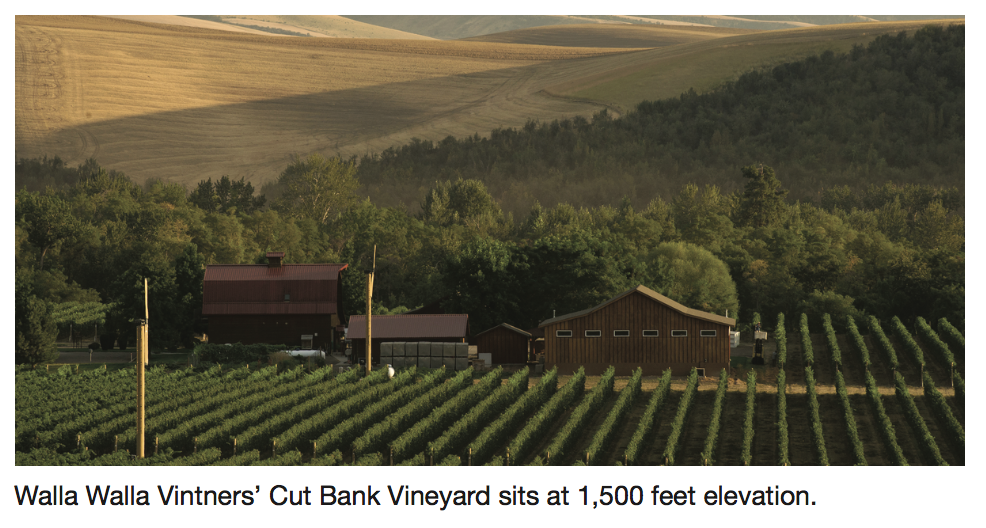 READ MORE »
READ MORE »
Top Stories
August 2017California Wildfire Season Nearly Claims Historic Vineyard
Santa Maria, Calif.—Fueled by high temperatures, low humidity and winds, the Alamo Fire that burned near Santa Maria came within feet of the revered Bien Nacido Vineyards before changing directions. The fire consumed nearly 29,000 acres before being contained, with more than 2,000 fire crews working on the blaze at its most destructive.
A fire three weeks earlier threatened Bien Nacido Vineyards, which was settled as a Spanish land grant in 1837 and planted to Chardonnay and Pinot Noir in 1973 by the Miller Family. An original adobe home from 1855 remains on the property today, surrounded by vines.
Reached during the fire, Nicholas Miller of the Miller family that owns Bien Nacido said the Alamo Fire had burned up to North Canyon Vineyard owned by Treasury Wine Estates, just to the north, but had stopped at the vineyard.
Nearby tasting rooms for Byron and Cambria were temporarily closed in response to the fire and smoke, and about 300 residents of Tepusquet Canyon were given mandatory evacuation warnings.
Rather than protecting California from wildfires, the wet winter led to rapid growth of weeds and grasses that quickly browned in the summer heat, providing ready fuel for wildfires, according to Cal Fire, which coordinates with local and federal agencies to combat wildfires.
Heather Williams, spokesperson for Cal Fire, reported that as of July 9, more than 68,000 acres had been consumed by fire in 2017 compared to 30,574 acres during the same dates in 2016. Williams called the numbers “staggering” and noted that the number of wildfires also increased by 635 from the previous year at the same time with 2,905 fires reported to the agency.
These fires were scattered across the entire state, with a completely random pattern. “We can never predict where they’ll break out,” Williams said. Variations in topography, weather and wind influence where and how far a given blaze will spread.
Unfortunately, even when vineyards are not physically singed, nothing can contain the billowing smoke. As grapes reach véraison, smoke presents an ongoing peril for growers that may not be fully determined until harvest.
Like homeowners, wineries should ensure they maintain 100 feet of defensible space around their structures. Additionally, vineyard managers are advised to clear dead weeds and vegetation as well as trim branches 6 feet from the ground.
READ MORE »
Top Stories
August 2017Debate Over Wine Labeling Continues in Canada
Ottawa, Ontario—A long-running battle over how Canada’s major vintners label wines bottled in Canada from a blend of imported and domestic juice is a centimeter closer to a conclusion.
READ MORE »
Top Stories
August 2017Ensuring a Successful Wine Bottling Day
Yountville, Calif.—Bottling day doesn’t have to be hard. With a little preparation, good supplier relationships and well-maintained equipment, bottling can be a smooth and efficient process.
READ MORE »
Top Stories
August 2017Southern Glazer's Hit with Lawsuit
San Rafael, Calif.—The nation’s largest wine wholesaler, Southern Glazer’s Wine & Spirits, is the target of a class-action lawsuit that alleges “unfair, unlawful, deceptive and fraudulent business practices” that run afoul of numerous state and federal laws.
The lawsuit was filed July 5 in the U.S. District Court of Northern California by the firms Scott Cole & Associates, APC and Wakeford Gelini on behalf of San Jose resident James C. Nguyen, who holds a liquor license for a San Jose restaurant and bar.
According to the lawsuit, Nguyen learned of the distributor’s alleged practices after he received a tax bill from the state for liquor he never ordered from the wholesaler.
His attorneys argue Southern’s management and employees made a habit of using their customers’ account numbers to process fraudulent purchases to either achieve sales quotas or drive up business for lucrative accounts. The lawsuit also alleges Southern sold alcohol to unlicensed third parties as well as provided full-size liquor bottles with “sample” labels for free or sold alcohol for a penny per bottle as a way to keep retailers and restaurants from reporting unethical behavior.
Southern is also accused of threatening to cut off supply if a restaurant or retailer didn’t buy sufficient quantities of certain brands and other brands offered by the wholesaler.
The goal, according to the lawsuit, was to maintain exclusive and profitable relations with top suppliers and extract as much profit as possible from restaurant and retail clients. “Through its unscrupulous, unethical and unlawful schemes detailed herein, Southern has enjoyed increased revenues, profitability and market share from its larger volume of sales,” the lawsuit alleges. “These practices have given Southern an unfair competitive advantage over its competition with a resultant disadvantage to the public and class members.”
The company’s practices, as described in the lawsuit, also allegedly helped secure “highly desirable and highly profitable supply relationships” and that “during the class period, Southern enjoyed numerous exclusive contracts with alcohol manufacturers/producers with a resultantly larger client base, more orders therefrom and higher profitability.”
A spokesman for Southern did not immediately reply to Wines & Vines’ request for comment but was quoted in other news reports as saying the company was reviewing the allegations in the lawsuit and did not have any comment.
READ MORE »
Top Stories
March 2017California Wine Harvest Tops 4 Million Tons
Sacramento, Calif.—The 2016 wine grape harvest totaled 4.0 million tons, up 8.5% from the 2015 crush.
Red wine varieties accounted for the largest share of all grapes crushed, at 2.26 million tons, up 10.5% from 2015. White wine varieties crushed totaled 1.75 million tons, up 4.9% from the previous year.
Raisin-type varieties accounted for 98,205 tons, a 6.2% increase, and table grape varieties totaled 97,729 tons, up 38.3% from 2015.
Glenn Proctor of Ciatti Brokerage said, “It was kind of an average crop, in line with what we expected.”
The price for 2016 red wine grapes was up 13.9% from the previous year, while white wine grapes increased 9.9% in price during the same period.
The average price paid for all varieties was $750.27 per ton, up 11.7% from 2015. Average prices for the 2016 crop by type were as follows: red wine grapes, $899.44, up 13.9% from 2015; white wine grapes, $594.01, up 9.9% from 2015; raisin grapes, $213.64, down 13.7%; and table grapes, $153.05, down 39.4%.
In 2016, Chardonnay continued to account for the largest percentage of the total crush volume with 16%. Cabernet Sauvignon accounted for the second-highest tonnage percentage with 13.3% of tons crushed.
Napa County crushed 146,558 tons, up 18.5% from 2015, with wineries crushing 105,093 tons of red grapes and 41,464 tons of white grapes. Sonoma County crushed 221,379 tons of wine grapes in 2016, an increase of 21.5% from the previous year; 127,149 tons of red grapes and 94,231 tons of white grapes were crushed in the county.
The next eight most-crushed varieties included only wine grapes. Thompson Seedless, the leading raisin variety crushed for 2016, held 2% of the total crush.
District 13, (Madera, Fresno, Alpine, Mono and Inyo counties, plus Kings and Tulare counties north of Nevada Avenue) had the largest share of the state’s wine grape harvest at 1.33 million tons. The average price per ton in District 13 was $301.59.
Grapes produced in District 4 (Napa County) garnered the highest average price of $4,666.35 per ton, up 7.3% from 2015. Cabernet Sauvignon was up 12% in price, from $6,224 to $6,943.
District 3 (Sonoma and Marin counties) received the second-highest return of $2,584.87 per ton, up 5.9% from 2015.
The most expensive lot was $59,375 per ton of Cabernet Sauvignon for 7.7 acres in Napa County. The highest price for Pinot Noir was $13,074 per ton for 2.4 acres in Sonoma County.
READ MORE »
Top Stories
March 2017Oak Conference to Explore Stylistic and Practical Decisions
Santa Rosa, Calif.—Making full use of a larger venue, the third annual Wines & Vines Oak Conference will feature content and technical tastings exploring the world of oak and other elements of winemaking.
READ MORE »
Top Stories
March 2017Washington Wine Industry Fills Tanks to Capacity
Kennewick, Wash.—With its latest crop in the range of 300,000 processed tons, leaders of the Washington state wine industry gathered in Kennewick last month looking to a future that could see vintners sending more wine into an unpredictable world.
With wine consumption up across the board and few of the key global wine regions with excess juice, Washington’s rising production of premium wines offers the right mix of richness and fruit to satisfy the world’s palate.
“Right now, inventory is much more of an asset for people,” said Steve Fredricks, president of Turrentine Brokerage, summarizing the industry for growers.
Judging by comments in Kennewick, Washington has plenty of inventory. Capacity at many wineries maxed out this year, with more than a few clusters left to hang on the vine for want of tank space—suggesting the state could have recorded a much larger harvest if space allowed.
Whether or not Washington wines will reach the world is another question.
READ MORE »
Top Stories
March 2017Professor Shares Lessons From Missteps by France and Australia
Sacramento, Calif.—A Sonoma State University professor revealed what North American wine producers can learn from their counterparts overseas during a session held Jan. 25 at the Unified Wine and Grape Symposium in Sacramento.
READ MORE »
Top Stories
March 2017Good Times Roll for U.S. Wine Industry
Sacramento, Calif.—The state of the U.S. wine industry is strong but subject to numerous challenges, according to authoritative observers who spoke Jan. 25 at the Unified Wine & Grape Symposium in Sacramento.
READ MORE »
Top Stories
March 2017Vineyards Submerged for Weeks in Lodi
Lodi, Calif.—Wine grape vineyards in the Lodi district were pummeled by rain through mid-February. Low-lying vineyards were not able to absorb all the water, and growers were unsure when they might be able even to begin pruning.
READ MORE »
Top Stories
February 2017Rain Soaks Vineyards, Closes Wineries
San Rafael, Calif.—After enduring half a decade of drought, vineyards in Northern California were drenched in the past month, but all that rain delivered problems as well.
READ MORE »
Top Stories
February 2017Wines Til Sold Out in Legal Fight
San Rafael, Calif.—One of the leading wine flash resellers, Wines Til Sold Out (WTSO), is facing a class-action lawsuit claiming it defrauded customers by offering wines for discounted prices that were not based on the wines’ true value.
READ MORE »
Top Stories
February 2017Ice Wine Harvested Coast to Coast
Kelowna, B.C.—Growers in British Columbia, Michigan and Ontario reported excellent conditions for an early harvest of grapes for the 2016 vintage ice wine.
READ MORE »
Top Stories
February 2017British Columbia Wine Store Auction for Grocers Wraps Up
Vancouver, B.C.—British Columbia auctioned off an additional six licenses for wine stores in December, but it could be months before the results are known.
“At this point, the results are being audited for fairness,” a spokesperson with the B.C. Ministry of Small Business and Red Tape Reduction, which oversees the B.C. Liquor Distribution Branch and the province’s state-run liquor distribution and sales regime, told Wines & Vines.
BC Auction, the government-owned vendor of surplus government assets, sold the licenses on six dates between Dec. 6 and Dec. 21. Auction terms required that bidders submit a deposit of $25,000 and place minimum bids of $125,000 for each license (all amounts are in Canadian dollars). Participation was limited to grocery retailers with stores no less than 10,000 square feet.
Ministry staff declined to identify the successful bidders, while the third-party audit is ongoing. On completion of the audit, approved purchasers will be able to make a formal application to license their premises to sell wine.
An initial round of auctions that concluded May 5, 2016, saw Loblaw Companies Ltd. of Brampton, Ontario, acquire six licenses for $6.9 million. It took the province six months to officially announce the results, though details were circulating among industry insiders well before then.
However, ministry staff said these auction results will “hopefully” be announced sooner than in the previous case, noting that the audit should proceed faster the second time around.
Bert Hick, principal of the liquor license consultancy Rising Tide Consultants Ltd. in Vancouver, said his sources indicate that final bids were again in the million-dollar range, but hard data has been tough to get. Loblaw is tipped among the successful auction participants, as is another major supermarket operator.
Successful license applicants from the latest round will join Overwaitea Food Group and Loblaw, which have been selling wine through the previous acquisition of licenses.
“If you connect all the dots, in my view, you could have two, maybe three major grocery groups that have exclusive control of wine on grocery store shelves in British Columbia,” he said.
READ MORE »
Top Stories
February 2017Wine Grape Broker Warns Market Already Tight for 2017
Santa Rosa, Calif.—The 2016 harvest in the North Coast was good—and in some cases may even have been remarkable—but demand has remained so strong since the short harvest of 2015 that the grape market remains tight.
Speaking at the Sonoma County Winegrowers’ annual Dollars & Sense conference held Jan. 12 at the Luther Burbank Center for the Arts, Glenn Proctor, a partner with global wine and grape broker The Ciatti Co., said attendees could be justified in playing a little hard to get this year when it came to selling their grapes. “The market is relatively tight,” he said.
Premiumization remains the big-picture trend, and just as demand increased for high-quality wine grapes to supply these higher priced wine programs, 2015 saw yields drop by nearly 30% in both Napa and Sonoma counties. The harvest also came in lower than normal in other coastal counties such as San Luis Obispo and Monterey.
Yields in the interior valleys were normal to good in 2015, but demand for those grapes has softened. In 2016, the situation was reversed: good harvests on the coast with shorter yields in the interior.
Yet the market for 2017 is looking similar to 2016, with strong demand and buyers out early trying to pin down the grapes they need. Current spot market prices for Sonoma County grapes include: Chardonnay for $1,700-$2,700 per ton; Cabernet Sauvignon for $2,800 - $3,800 per ton, and $2,700-$4,800 per ton for Pinot Noir.
Proctor also revealed some insights from Ciatti’s annual survey of its clients about their grape and wine needs for the coming year. He said Cabernet Sauvignon and Chardonnay are the most sought after grapes with Zinfandel the least needed, possibly the result of a shift in the market toward red blends.
Another Ciatti partner, Chris Welch, followed Proctor and said the current bulk wine market is “overall balanced statewide.”
He said Russian River and Sonoma County Chardonnay is fetching high prices with wineries also seeking wine from Monterey and Lake counties to blend down costs or improve California appellation programs. Sauvignon Blanc is in short supply, and Welch said there’s large demand for the varietal.
There’s not as strong demand for bulk Zinfandel, and Welch said Pinot Noir continues to be highly sought after.
Welch said the market may have seen its peak for Napa Cabernet.
READ MORE »
Top Stories
February 2017DtC Wine Shipments Pass 5 Million Cases and $2.33 Billion
Concord, Calif.—Direct-to-consumer shipments passed 5 million cases in 2016, with value reaching $2.33 billion, Kent Nowlin, general manager of Sovos ShipCompliant, reported last month at the Direct to Consumer Wine Symposium held at the Concord Hilton.
The new figures were part of a preview Nowlin offered from the seventh annual DtC Wine Shipping Report, which provides a comprehensive review of direct-shipment data including sales, volume and varietal trends from the past year. The report and preview was prepared with data generated jointly by ShipCompliant and Wines Vines Analytics.
DtC shipments have shown steady growth during the past six years, growing from less than
READ MORE »
Top Stories
February 2017Oak Conference Moves to Sonoma County
READ MORE »
Top Stories
January 2017Nearly 75% of California Still in Drought
San Rafael, Calif.—While California soaked up a string of much-needed winter storms in December, it’s still unclear if this winter will bring enough rain to break the state’s longstanding drought.
The storms culminated Dec. 15 when Napa, Calif., received 2.13 inches of rain, and the Santa Rosa area (Sonoma County) recorded 2.5 inches in just one day. The heavy rains pushed most of the state well past the historical averages to date and filled many reservoirs to average or above average, but the storms did not deliver much snow to the Sierra Nevada.
Since the start of the water year on July 1, Ukiah (Mendocino County, Calif.) saw 15.82 inches and is 126% of average. The Central Coast city of Paso Robles, Calif., has received 3.4 inches and is 106% of average, and Monterey, Calif., has recorded 5.27 inches and is 92% of average, according to Weather Underground.
The storms filled nearly all of the state’s major reservoirs to their averages for this time of year. On Dec. 18, Lake Shasta was at 72% total capacity, or 118% of its average, Lake Folsom was at 57% total capacity and 117% of average, and the San Luis Reservoir was 56% of total capacity and 86% of its average. Other reservoirs like Lake Oroville (Butte County) and New Melones (Sierra Foothills) remained far below average.
While the downpours have been most welcome, there has not been as much snow, and the snowpack in the Sierra Nevada is critical to California’s total water supply. “We are getting some precipitation in the northern part of the state, but not as much snowpack development as we would like,” said Michael Anderson, climatologist with the California Department of Water Resources.
“Drought in California is now more of a regional issue based on a locality’s water supply portfolio and the demands they have for that supply,” he said, noting the less-than-average snowpack and that Oroville Reservoir was 300,000 acre-feet below average.
Looking ahead, Anderson said “La Niña-ish” conditions and unsettled high pressure will bring a mix of rain and cold and dry weather, which makes it uncertain if this winter is on track to break the drought statewide. “We will have to wait and see how the rest of this winter plays out to see how drought conditions are impacted regionally,” he said.
READ MORE »
Top Stories
January 2017Slow Restaurant Traffic Not Affecting Wine
Port Washington, N.Y.—Reports that restaurant traffic is declining may have concerned some wineries, but a closer look indicates that it doesn’t seem to be affecting on-premise wine sales. The decline most affects fast food, which represents 80% of the market but very little wine business.
READ MORE »
Top Stories
January 2017Smoke Leaves Unwanted Mark on Carmel Valley Wine Grapes
San Rafael, Calif.—This past summer, as the Soberanes Fire raged in Monterey County, winemakers and growers in the Carmel Valley watched as heavy smoke descended on their vineyards right around véraison. Many of those affected hoped their still-developing grapes would dodge any smoke contamination, but now that most wineries in the region have pressed off their 2016 reds, it appears that several have had to deal with extensive smoke problems.
READ MORE »
Top Stories
January 2017Climate Change Upsets Tradition, Demands Winemaking Flexibility
Stuttgart, Germany—Climate change so far has been good to northern European winemakers, allowing them to make internationally acclaimed red wines for the first time and riper dry white wines in regions traditionally considered to have cool climates. But enology professor Dr. Monika Christmann of Geisenheim University told a group of mostly German winemakers and researchers Nov. 29 that climate change may also necessitate more technological intervention in winemaking.
READ MORE »
Top Stories
January 2017Okanagan Valley Grapegrowers Face the 64,000-Bug Question
Penticton, British Columbia—The invasive insect brown marmorated stink bug recently was found at a riparian site near Penticton in British Columbia’s southern Okanagan Valley.
Originally from Asia, the stink bug has become a leading cause of damage to tree fruits on the East Coast. Its detection in the Okanagan is the first in a major fruit-producing area of British Columbia, although there are signs that it may have become established in pockets of the province’s Lower Mainland. Vancouver is the country’s busiest port of entry, and several bugs have been intercepted on incoming shipments in recent years.
Betsy Beers, an entomology professor at Washington State University in Wenatchee, said the appearance of the pest in Penticton means it’s only a matter of time before it wings its way across the U.S.-Canadian border to Okanogan County, Wash. The bug has been identified in 17 counties in the state to date.
The good news for everyone, however, is that the pest takes years to become established in sufficient numbers that it can cause economic damage to agricultural crops.
“We have had no absolute, verified reports of damage in Eastern Washington in our primary ag-production areas,” Beers said. “Usually, the last frontier is to move out into agricultural areas.”
Small you-pick operations within the city limits of Vancouver, Wash., have been the only significant agricultural impacts seen to date, consistent with the pest’s preference for temperate, urban locations.
The pest typically overwinters in homes and avoids the climate extremes typical of the interiors of British Columbia and Washington.
While the number of bugs detected in Eastern Washington surged into the hundreds this year from just a few dozen in 2015, the largest numbers were found in the residential areas of Yakima and Walla Walla.
Walla Walla grapegrowers aren’t expressing alarm, however. Jason Magnaghi, viticulturist with Figgins Family Wine Estates in Walla Walla, said the pest isn’t present at levels that would damage wine quality.
While a crushed stink bug produces an unpleasant odor and could potentially taint wines in a manner similar to Asian lady beetles, Magnaghi said the insects have been drawn more to orchards than vineyards.
READ MORE »
Top Stories
January 2017Washington State Vineyards Attract Immigrant Investment
Walla Walla, Wash.—A little-known financing vehicle that garners funding from immigrant investors is fueling a 368-acre vineyard-oriented enclave in Eastern Washington.
READ MORE »
Top Stories
January 2017Pinot Gris Virus Discovered in More Napa Vineyards
Davis, Calif.—Grapevine Pinot Gris virus (GPGV) has been detected in vineyards in 14 locations in Napa County, but not in other California vineyard locations to date, based on initial findings from a statewide survey started in 2016 and funded through an American Vineyard Foundation research grant.
READ MORE »
Top Stories
January 2017Vineyards Lose Labor to Marijuana Growers
Boonville, Calif.—California’s marijuana and grapegrowers are at odds over more than water. They also are vying for the same labor pool at harvest time.
Travis Foote, general manager of Vineyard Logistics, said his Mendocino County vineyard-management company started this year’s harvest in mid-August with 22 pickers. Less than six weeks later, he was down to eight.
“The marijuana pay is much better, and the work is much easier,” Foote said. “They pay cash, and people can do the work from home a lot of the time. Marijuana doesn’t require a lot of labor the rest of the year, but when we need workers the most, they need workers the most.”
The problem is particularly acute in Mendocino County, especially the Anderson Valley. A perfect storm of factors makes getting reliable help harder: a smaller labor pool, a proliferation of marijuana growers and vineyards that are often too small and too remote for mechanized harvesting.
“I’m terrified” about looming mechanization, said Webster Marquez, owner/winemaker at Anthill Farms. “Artisans who want things done by hand are going to have to pay up more than we already are.”
It’s a recent but not new dilemma in the northern reaches of wine country. “When we’re picking grapes out there in the middle of the night or early morning, that’s difficult manual labor,” Foote said. “It’s really hard work and long hours, so they go find something else.”
Migrant workers also are becoming more the exception than the rule, as wineries, growers and vineyard-management companies have been shifting to full-time crews.
Most of the laborers at La Prenda Vineyards Management in Sonoma, Calif., work 11 months per year, said owner Ned Hill. “We’re in a big labor shortage and have done everything we can to make them full-time employees.”
Marquez added that the migrant-labor pool “has slowed down practically to a trickle.
READ MORE »
Top Stories
December 2016Top Stories
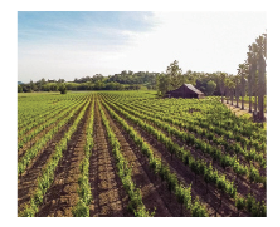
Silver Oak buys vineyard
READ MORE »
Top Stories
December 2016Has the Sizzle Left Wine Flash Sales?
San Rafael, Calif.—In 2011, Wines Vines Analytics began tracking what was then the relatively new trend of third-party websites selling wine at deeply discounted prices for a short amount of time.
READ MORE »
Top Stories
December 2016How Will a Trump Presidency Affect the Wine Industry?
READ MORE »
Top Stories
November 2016West Coast Wine Grape Harvest Almost Over
San Rafael, Calif.—Wines & Vines’ periodic reports from diverse winegrowing regions throughout the spring and summer indicated a relatively peaceful growing season. As crush wound down in mid-October, wine grape growers and winemakers throughout California and the Northwest indicated favorable quality and yields.
READ MORE »
Top Stories
November 2016Constellation Trades Canada for Washington
Toronto, Ontario—The pensions of Ontario’s teachers will benefit from sales of some of Canada’s best-known wines, following the announcement that their pension manager has agreed to acquire Constellation Brands Inc.’s Canadian division. The news broke the same day that Constellation revealed its plan to purchase five Washington state wine brands from Charles Smith.
READ MORE »
Top Stories
November 2016Mergers and Acquisitions from Both Sides
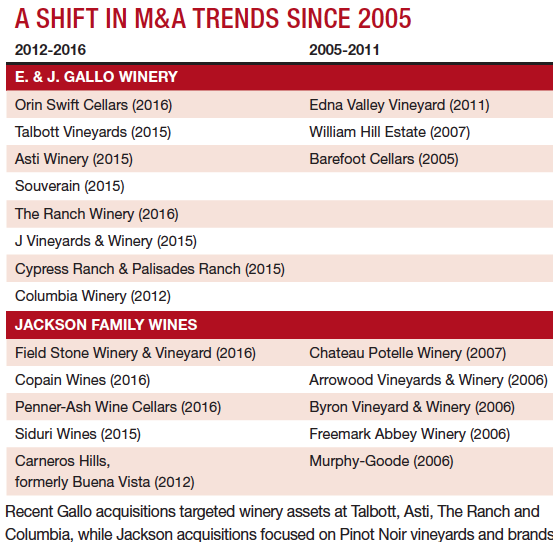 READ MORE »
READ MORE »
Top Stories
October 2016California Farm Workers Win Overtime Battle
Vineyard workers install stakes for new plantings in California, where new overtime laws for agriculture will be phased in starting in 2019.Sacramento, Calif.—Gov. Jerry Brown signed AB 1066 into law Sept. 12, ending a lengthy legislative battle to put farm worker overtime pay on par with that of employees in other industries. When fully in effect, the measure will require overtime pay after an eight-hour workday or a 40-hour week, vs. the current 10-hour day or 60 hours per week.
The changes allow grapegrowers and other farming businesses an adjustment period, with a four-year phase-in beginning in 2019. Businesses employing 25 or fewer farm workers will have an additional three years to comply.
Since a 2015 report from California Employment Development Department’s Labor Market Information Division counted 423,780 agriculture workers in the state, the issue is large in scope. The United Farm Workers (UFW) vigorously supported the measure, which spent two years being reworked and revised in the California state legislature. The UFW planned celebrations at offices around the state. A UFW statement said the new law corrects 78 years of discrimination against farm workers and sets an example for other states.
While the governor’s signature was still pending, U.S. Labor Secretary Thomas Perez applauded its passage and urged Gov. Brown to sign. He said that the farm workers who feed the nation should make enough to pay for their own meals, and added that the long lead time would not break the bank for employers.
In an email to Wines & Vines, state senate candidate and former assemblywoman Mariko Yamada of Davis, Calif., was jubilant. “For nearly 80 years, farm labor has been valued differently than other work in our great state. AB 1066 addresses this inequity in a thoughtful and incremental way.”
Grapegrowers express concern
READ MORE »
Top Stories
October 2016TSG Partners Equity Firm Buys Duckhorn Wine Co.
Duckhorn Wine Co. starting expanding nearly 30 years ago and always referenced ducks in its names.St. Helena, Calif.—TSG Consumer Partners acquired Duckhorn Wine Co. from investment firm GI Partners. Financial terms of the transaction were not disclosed.
TSG is a $5 billion San Francisco-based strategic equity investor in consumer brands in the food, beverage, household, personal care, apparel and e-commerce sectors. Its past and present investments include Pabst Blue Ribbon, Arrowhead Mills, vitaminwater, thinkThin, popchips, Muscle Milk, Stumptown, Planet Fitness, Revolve, Paige, Smashbox Cosmetics, Pureology, Sexy Hair, e.l.f. cosmetics and IT Cosmetics.
Prior to the announcement, rumors swirled that Constellation Brands would acquire the wine company, but Duckhorn president and CEO Alex Ryan vigorously denied that it was for sale.
The transaction includes all six Duckhorn Wine Co. brands—Duckhorn Vineyards, Goldeneye, Paraduxx, Migration, Decoy and Canvasback—and their corresponding properties. The properties include more than 600 acres of estate vineyards, including the legendary Three Palms Vineyard in Napa Valley.
All employees are being retained, including the winemakers for all six wineries and CEO Ryan, who has been with Duckhorn since 1988.
Co-founders Dan and Margaret Duckhorn also will remain involved.
Duckhorn championed Merlot
READ MORE »
Top Stories
September 2016Economic Impact of California Wine: $114B
 * FTE = Full time equivalent. Source: John Dunham & Associates/Wine Institute
* FTE = Full time equivalent. Source: John Dunham & Associates/Wine InstituteSan Francisco, Calif.—The California wine and wine grape sector and allied businesses delivered an economic contribution of $57.6 billion to the state’s economy in 2016 and $114 billion to the overall U.S. economy, according to a new report commissioned by Wine Institute and the California Association of Winegrape Growers.
The figure represents about $98.90 billion in total economic output without taxes, or roughly 0.55% of the U.S. 2015 GDP of $18.2 trillion.
The report, “The Economic Impact of California Wine and Grapes 2015,” prepared by John Dunham & Associates of New York, was presented Aug. 4 at a joint informational hearing of the California Assembly Committee on Agriculture and Assembly Select Committee on Wine held at the University of California, Davis.
The study defines the California wine industry as wine grape growing, wine production and wine-related tourism in the state of California as well as the wholesaling, retailing and direct-to-consumer sales of California wine in all 50 states, plus the District of Columbia.
Wine producers, wholesalers and retailers directly employed 447,982 Americans in 2015. These workers earned more than $16.32 billion in wages and benefits. When supplier and induced impacts are taken into account, the California wine industry is responsible for 786,387 jobs in the United States and $34.92 billion in wages as well as $14.14 billion in direct federal, state and local taxes, not including state and local sales taxes imposed on California wine. The combined totals for economic output, wages and California wineries and vineyards directly and indirectly generated 325,000 jobs in California and 786,000 jobs across the nation last year.
Independent California growers employ 34,614 in growing wine grapes, and California wineries and the vineyards they own directly employ 30,823 people in the state. California wine tourism is directly responsible for 47,552 jobs in the state.
The report shows growth of 17% in statewide impact (from $49.2 to $57.6 billion) and 19% in national impact (from $96.0 to $114.1 billion) in the past seven years.
This strong growth during a period that started with the Great Recession in 2008 and continued with slow recovery shows the strength and resiliency of the nation’s No. 1 wine-producing state as a positive economic force across the country.
Nevertheless, the growth in economic impact didn’t match the value of retail wine sales growth, according to figures from the Wine Institute. It did exceed the volume shipped to U.S. markets, however.
California shipments to the U.S. market grew from 201.6 million cases in 2008 to 229 million in 2015, a 13.6% increase. Retail value increased from $26.1 billion to $31.9 billion, a 22.2% rise.
Dunham said that this results from the economic model including some items like tourism that don’t correlate directly with wine sales. “They’re different models, and some are measured differently.”
Associations comment
READ MORE »
Top Stories
September 2016California Harvest Early; Volume Sparse
A picking crew harvests Pinot Meunier from Green Island Vineyard for Mumm Napa on July 28.San Rafael, Calif.—When Wines & Vines began our annual check on vineyard conditions in mid-July, véraison was just beginning in much of California. By early August, however, crush had commenced for North Coast sparkling wine producers. Winter precipitation replenished reservoirs, rivers and aquifers and a generally mild growing season allowed many vineyards to reduce or eliminate irrigation, but mildew pressure had been intense in much of the state.
READ MORE »
Top Stories
August 2016Cost of Brexit Will Fall on UK Consumers
The United Kingdom is a popular export market for North American wineries, though consumers may reject the idea of paying more for wine from California and other regions after currency fluctuations.San Rafael, Calif.—The fallout from what’s known as Brexit—Britain’s exit from the economic union of 28 European countries—has unleashed the greatest upheaval since Greece threatened to default on its obligations to the EU. The market where exchange rates and product prices will bite most is the United Kingdom, where the pound plummeted versus the dollar on June 24.
READ MORE »
Top Stories
July 2016Strong Demand Meets Tight Grape Supply
According to the CDFA's Grape Crush Report, the 2015 wine grape harvest was down sharply from the record high reported in 2013.San Rafael, Calif.—Green clusters have formed on vineyards throughout California, and the early word is that while the 2016 crop won’t be as light as last year, it also won’t be anything like the large harvests of a few years ago.
READ MORE »
Top Stories
July 2016Treasury Consolidates and Sells Wineries
Winemaker Domenica Totty oversees a pumpover at Beaulieu Vineyard, which recently invested in updating winemaking facilities for its top-tier labels.Napa, Calif.—As expected after its $552 million purchase of the majority of spirits giant Diageo’s wine business in October, Treasury Wine Estates (TWE) is consolidating production of those brands with its existing brands.
TWE’s most significant moves are to consolidate much of its luxury wine production (bottles that sell for more than $20 retail) at the Beringer Vineyards facility on Pratt Avenue in St. Helena, Calif., and most “masstige” brands (bottles selling for $10-$20 retail) at the facility in Paso Robles, Calif., that was once Meridian Winery.
However, TWE will continue to make top-tier labels Beaulieu Vineyard and Sterling Vineyards at those wineries and maintain winemaking at three other luxury producers in Napa Valley.
TWE now has two wineries at the Sterling property located south of Calistoga, Calif. One, which is very popular with visitors, is at the top of its knoll. The other is little noticed and at the bottom of the sweeping hill. Currently they make the reserve wines at the bottom and all others at the top of the hill.
The new plan will transfer production of the very highest level wines like Platinum and Iridium to the top of the hill and make a multi-million-dollar investment to modernize the winemaking facility.
Spokesperson Megghen Driscol said, “Not only will this increase quality, but it will make for a better experience for consumers who take the self-guided tour at Sterling.”
All other Sterling luxury winemaking will be moved to the Pratt Avenue winery.
As at Sterling, the company is investing several million dollars in the Beaulieu Vineyard (BV) winery in Rutherford to modernize and make best-in-class wines with an emphasis on the high-end reserve winemaking. These upgrades will allow the winemaker to make Georges deLatour, Tapestry and a select few direct-to-consumer-only wines onsite at BV. All other luxury BV winemaking will be moved to the Pratt Avenue winery.
Also in Napa Valley, the company will continue producing the high-end wines Étude, Stags’ Leap and Provenance at their existing facilities.
In another significant move, the company will discontinue winemaking at Chateau St. Jean winery in Sonoma County and transfer production to Beringer in St. Helena.
All hospitality and direct-to-consumer functions remain at the site. This is similar to the situation at St. Clement Vineyards in Napa Valley, which now serves primarily as a hospitality center.
TWE’s Driscol described this arrangement as very similar to a winery co-op or “winemaker studio.”
“We are merely changing where CSJ is made. This will allow us to not only take advantage of scale and efficiency but will give our team a state-of-the-art luxury winery to make their wines in. Regardless of these changes, they remain committed to supporting and investing in Chateau St. Jean, and we have some exciting growth plans ahead for the brand.”
Masstige wines move to Paso Robles
READ MORE »
Top Stories
July 2016Pennsylvania Liberalizes Wine Sales, DtC
Pennsylvania Gov. Tom Wolf signs a bill that will allow grocery stores and convenience stores to sell wine outside of the "state store" system.Harrisburg, Pa.—Gov. Tom Wolf changed Pennsylvania’s status as a “control state” on June 8, when he signed H.B. 1690, a bill that will permit the direct shipping of wine to Pennsylvania residents over 21 years of age. For years, Pennsylvania was one of two “control states” that permitted the sale of liquor and wine only at “state stores.” One exception was made in 1968, when legislation was passed that allowed “limited wineries” in the state to produce and sell up to 250,000 cases of wine per year.
Steve Gross, vice president of state relations at the California-based Wine Institute, told Wines & Vines that with this new law in place, Pennsylvania becomes the 44th state where U.S. wine producers can ship wine direct to consumers (DtC). He noted, “Now Pennsylvania consumers will be able to get wines that consumers in other states can order.”
According to Jeremy Benson, director of Free the Grapes, Pennsylvania is an important state—not just for California wine producers, but for producers across the country. “First, Pennsylvania is the 12th largest wine-consuming state in the country. Second, it’s by far the largest state that effectively bans DtC sales currently, and third, there’s a lot of latent demand in the state for DtC wine sales,” Benson said.
Wines & Vines spoke with two California wine producers who are already selling their wines through the PLCB state stores. Both were very enthusiastic about the possibilities for increased sales in Pennsylvania. Dennis Cakebread, senior vice president of sales and marketing for Cakebread Cellars in Rutherford, Calif., noted, “It’s good for consumers to have the freedom of choice. The amazing part is how long it took to get this law passed.”
Cheryl Murphy Durzy, vice president of Clos LaChance Wines in San Martin, Calif., commented, “We’re already selling in the state stores and have good brand awareness in Pennsylvania. This will allow people to get some limited, really cool wines that they weren’t otherwise able to get.”
In order to sell DtC under the new law, wine producers must acquire a direct wine shipper license at a cost of $250 annually as well as a sales tax license. The winery then will pay $2.50 per gallon sold, plus Pennsylvania’s 6% sales tax and any applicable local sales taxes.
Each consumer may purchase up to 36 cases per year from a given wine producer. “Thirty-six cases is a generous amount—more than in some states, although the tax component of $2.50 per gallon is one of the higher gallon taxes,” Gross said. He added that the tax rate could have been much higher if the 18% “Johnstown Flood Tax” (applied currently to the wholesale price of wine in state-owned stores) had been included in the tax calculation.
Technically, Pennsylvania has permitted DtC wine sales for about 10 years. After the U.S. Supreme Court handed down its decision in the 2005 Granholm v. Heald case, ruling that a state could not have different direct shipping rules for in-state wineries than for out-of-state wineries, Pennsylvania set up a complicated system to comply with the ruling. Out-of-state wineries had to obtain a license and then ship all wines sold to a state-owned store for pickup by the customer. Smaller out-of-state wineries could get a limited winery license and then ship directly to Pennsylvania customers. According to the Pennsylvania Liquor Control Board, there are only 22 active out-of-state limited wineries.
Not surprisingly, this method of complying with the Granholm decision did not work well for either wine producers or Pennsylvania’s wine-consuming residents.
Both Wine Institute and Free the Grapes have worked for years to get Pennsylvania to liberalize and change its liquor laws. “Wine Institute deserves credit for keeping after this for years and years,” Benson said. “It’s been a goal of Free the Grapes and the wine-producing community. We think it’s a big win for Free the Grapes.”
Other provisions of H.B. 1690
READ MORE »
Top Stories
June 2016Winery Sales Continue at Brisk Pace
Oakville, Calif.—Far Niente Wine Estates confirmed May 17 that it was selling a majority interest in the company to GI Partners of Menlo Park, Calif. The Far Niente group encompasses four winemaking facilities, 300 acres and 75,000 cases total production.
The historic Far Niente estate produces 30,000 cases of its flagship wine, plus 20,000 cases of Nickel & Nickel wines, 1,500 cases of Dolce sweet wine, 10,000 cases of EnRoute wines and wines from the newest winery in the group, Bella Union.
Dirk Hampson, chairman and director of winemaking, described the deal as a strategic investment in the company, including vineyards, wineries, brands and a farming company, Vinescape.
The announcement came one day after Jackson Family Wines announced the purchase of Copain Wines in Healdsburg, Calif., and three weeks after the annual North Bay Business Journal Wine Conference tackled the subject of mergers and acquisitions.
Acquisition trends
READ MORE »
Top Stories
June 2016U.S. Wine Tax Bill Inches Forward
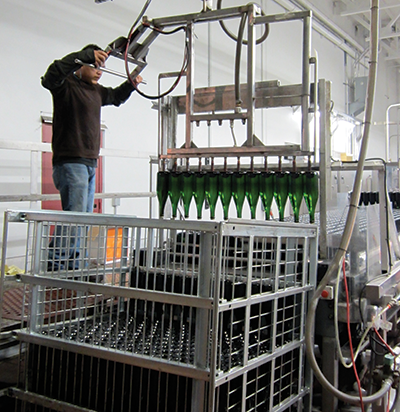 In addition to requiring specialized equipment to produce, sparkling wine is currently taxed at a higher rate than still wine.
In addition to requiring specialized equipment to produce, sparkling wine is currently taxed at a higher rate than still wine.Washington, D.C.—A bill proposed by California congressman and vineyard owner U.S. Rep. Mike Thompson and U.S. Rep. Dave Reichert of Washington state made a step forward May 12 to streamline and reduce excise taxes within the wine industry.
A statement from Thompson’s D.C. office said that H.R. 4934 was referred to the House Committee on Ways and Means for further consideration. “In a Tax Policy Subcommittee hearing earlier today, a number of members voiced support for modernizing alcohol excise taxes. As a senior member of the committee, Rep. Thompson will continue to advocate for his bill until the chairman brings up the legislation for the committee’s consideration,” Thompson spokeswoman Megan Rabbitt told Wines & Vines via email.
H.R. 4934 has drawn most attention within the wine industry because it would slash the excise tax on sparkling wines from $3.40 per gallon to $1.70 per gallon, equal to the current tax on still wines. But the bill would also reduce the excise tax by 50 cents per gallon on many still wines with alcohol content higher than 14%.
Since sparkling wine already requires more steps and costs in production, the excise tax has created an extra burden for producers and inhibited many small wineries across the country from adding sparkling wines to their portfolios.
Eileen Crane, CEO and founding winemaker of 45,000-case Domaine Carneros in Napa, Calif., commented, “I’m ecstatic that Mike Thompson is taking this on.”
She added, “This is an incredible thing for a sparkling house. The sparkling wine tax is truly punitive. As a result, it is very hard to make a go of sparkling wine production. There are only about 20 sparkling wineries nationally producing over 2,000 cases. Compare that to the many thousands of still wine producers. And of those 20 sparkling houses, many have changed hands over the last 30 or so years, largely because of the tax in my opinion.
“We sparkling producers have despaired of ever having anyone stand up for us because we are such a small contingency, but Mike has taken this on. Let’s just make it right,” she said.
Not just for sparklers
READ MORE »
Top Stories
May 2016Will Wage Hike Affect the Wine Industry?
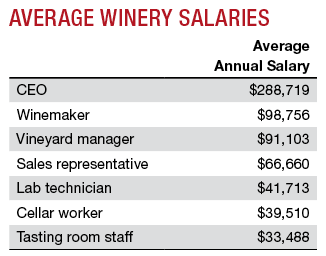 Source: Wine Business Monthly 2015 Salary Survey
Source: Wine Business Monthly 2015 Salary SurveySacramento, Calif.—All businesses in California will be required to increase minimum wages, capping out at $15 per hour in 2022. On April 4, Gov. Jerry Brown signed legislation into law that will gradually raise the state’s minimum wage during a six-year period; small businesses with fewer than 25 employees may receive postponements.
READ MORE »
Top Stories
May 2016Constellation No Prisoner to Hard Assets
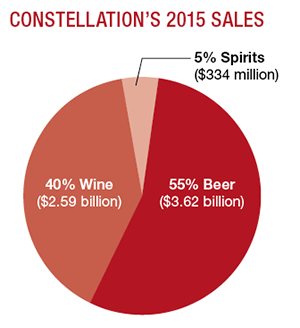
Victor, N.Y.—It’s been a busy few months for Constellation Brands. The world’s largest wine company by volume released strong earnings, announced that it had bought the hot Prisoner wine portfolio and disclosed that it was considering spinning off much of its Canadian wine holdings in a public offering.
For its 2016 fiscal year ending Feb. 29, Constellation reported sales of $6.55 billion ($7.22 billion before excise taxes), up 9% including gains from Meiomi wine and Ballast Point beer, both of which it acquired during the past year.
The numbers tell how much the company depends on beer, however: Beer sales were up 14% to $3.62 billion, and beer profits were up 21% to $1.78 billion (49% gross profit) on beer volume up 11.3%, while its U.S. wine and spirits volume was up 2.4%
Wine sales were up 3% to $2.59 billion, and spirits sales were up 6% to $334 million.
Wine and spirits profits are consolidated and amount to $1.24 billion or 42% (up 5%).
Beer accounts for 55% of Constellation’s sales, wine 40% and spirits 5%.
Its beer brands include imports Corona, Modelo and Pacifico, plus Ballast Point, the hot domestic craft beer.
Constellation’s “focus” wine brands are Black Box, Clos du Bois, Estancia, Franciscan Estate, Inniskillin, Kim Crawford, Mark West, Meiomi, Mount Veeder, Robert Mondavi, Ruffino, Saved, Simi, The Dreaming Tree and Wild Horse.
Constellation is projecting net sales growth in the mid-single-digit range and mid- to high single-digit growth in operating income for wine and spirits, including incremental benefits from Meiomi, which the company acquired for $315 million last year, and The Prisoner, which it is buying for approximately $285 million.
The Prisoner portfolio
READ MORE »
Top Stories
April 2016Diageo Helps Treasury Back From Cliff
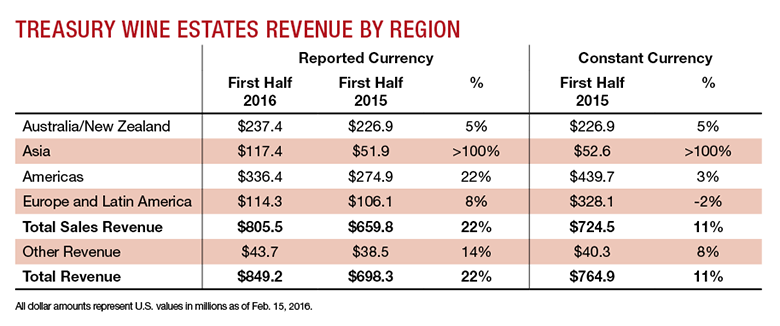
Napa, Calif.—After a troubling recent past, Treasury Wine Estates (TWE) seems to have recovered its footing in the global wine industry and is even thriving.
On Feb. 18, TWE announced its interim 2016 financial results, with net profits after tax more than double the previous period at $65.6 million (all figures in USD) on a reported currency basis and up 39% on a constant currency basis.
Earnings before interest, tax, assets and material items were up 72% to $109.6 million.
The company’s Americas division reported a 67% increase in earnings to $56 million. Sales growth has been fueled by the new focus on higher priced wines and reshaping the company’s U.S. portfolio.
European earnings also doubled to $12.7 million, and earnings grew by $19.4 million to $35.1 million in Asia.
The change in the company’s overall strategy, which has been led by CEO Michael Clarke, who took the job in February 2014, appears to have paid off for TWE.
The new strategy also paid off for Clarke, who received a 30% raise to $1.6 million per year in March. In announcing the pay increase, the company noted the “significant turnaround of the business,” and chairman Paul Rayner said Clarke’s “vision and leadership has been critical to TWE achieving outstanding results for our shareholders.”
TWE’s U.S. operations also have a new boss. The company announced Bob Spooner as the new president of TWE Americas in February. Spooner joined the company in January 2015 as chief supply officer to help make the shift toward more luxury and premium brands.
Outlook wasn’t so positive
READ MORE »
Top Stories
April 2016Researchers Confirm Red Blotch Vector
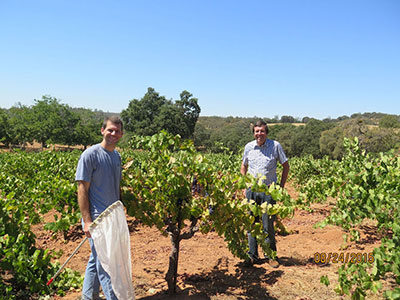 Brian Bahder (left) and Frank Zalom with the University of California, Davis, look for insects at a red blotch-infected vineyard in Amador County.
Brian Bahder (left) and Frank Zalom with the University of California, Davis, look for insects at a red blotch-infected vineyard in Amador County.San Rafael, Calif.—A team of researchers with the University of California, Davis, identified the three-cornered alfalfa treehopper (Spissistilus festinus) as the first confirmed vector of red blotch-associated virus in greenhouse tests.
READ MORE »
Top Stories
March 2016Are You Sure You Need a Wine Bond?
Washington, D.C.—Everyone in the wine industry knows that any business involved with alcohol is heavily regulated at the state and federal levels. On Dec. 18, 2015, that regulatory weight got a little bit lighter for approximately 80% of the wineries across the country. That was the day U.S. president Barack Obama signed the Consolidated Appropriations Act (also known as the Fiscal Year 2016 Omnibus Appropriations Bill) into law. Unbeknownst to most wineries, one section of the law, the Protecting Americans from Tax Hikes Act of 2015 (a.k.a. “the PATH Act”) included changes to excise tax due dates, bond requirements and the definition of wine eligible for the “hard cider” tax rate. Wineries should note, however, that these changes will not take effect until January 2017.READ MORE »
Top Stories
March 2016West Coast Wine Grape Tonnage Falls
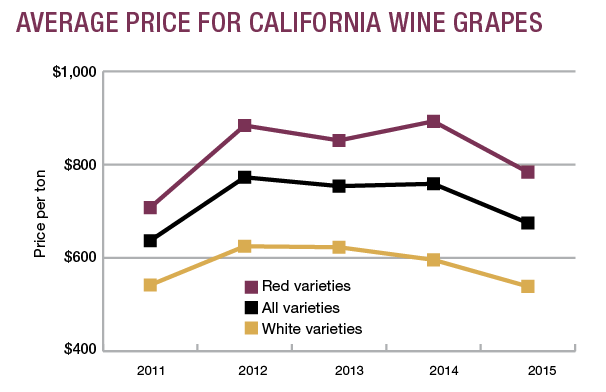
San Rafael, Calif.—California’s wine grape production slipped 5% in 2015, and average prices for wine grapes fell by as much as 12% from the previous year, according to the preliminary California Grape Crush Report released Feb 10.
In Washington, the 2015 harvest came in 2% smaller than the previous year at 222,000 tons. While there are still no hard numbers about the harvest in Oregon, the sense is that state will record another harvest of large size and exceptional quality.
According to the California Department of Food and Agriculture and the USDA’s National Agricultural Statistics Service, which prepared the preliminary report about California’s harvest, red wine grape production in 2015 dropped 5% from the previous year to 2.04 million tons, and white grapes also slipped 5% to 1.66 million tons. The total wine grape harvest of 3.69 million tons in 2015 represented a decrease of slightly more than 5% from the 2014 harvest.
Two harvests, two markets
READ MORE »
Top Stories
February 2016Distributors Change Winery Landscape
Washington, D.C.—A merger involving two of the four largest wine and spirits distributors in the United States could make things easier for big wine companies but even tougher for small wineries and those trying to break into the market.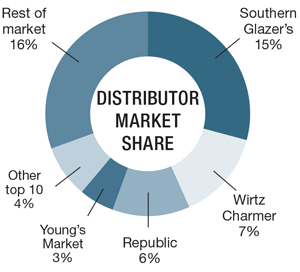 READ MORE »
READ MORE »
Top Stories
February 2016Winegrowers Can't Rely on El Niño
Sacramento, Calif.—The much-anticipated El Niño winter has brought some precipitation to parched California and begun to replenish the vital Sierra Nevada snowpack. But according to experts including the National Weather Service in Sacramento, a single “normal year” will not redeem the state from the ravages of a four-year drought.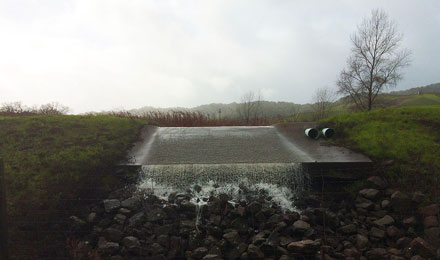 A vineyard reservoir overflows Tuesday in the Oak Knoll AVA of Napa Valley. In spite of intense seasonal rains, water researchers say these winter storms are unlikely to repair the damage done by a four-year drought.READ MORE »
A vineyard reservoir overflows Tuesday in the Oak Knoll AVA of Napa Valley. In spite of intense seasonal rains, water researchers say these winter storms are unlikely to repair the damage done by a four-year drought.READ MORE »
Top Stories
January 2016Wine Industry Escapes Retaliatory Tariffs
 Canada’s International Trade Minister Chrystia Freeland had promised retaliatory tariffs would follow WTO authorization.
Canada’s International Trade Minister Chrystia Freeland had promised retaliatory tariffs would follow WTO authorization.Washington, D.C.—Wineries that export to Canada and Mexico have escaped significant tariffs following lawmakers’ repeal of Country of Origin Labeling (COOL) for beef and pork in accordance with a recent World Trade Organization (WTO) ruling.
On Dec. 7, an arbitrator with the WTO reiterated decisions the international trade organization has delivered since 2011, deeming COOL requirements an undue regulatory burden on foreign meat producers and a potential cause of inaccurate labeling in stores.
Originally adopted in 2002, successive changes to COOL requirements have cost livestock producers in Canada and Mexico billions of dollars. The latest WTO decision marked the end of the road for U.S. appeals and opened the door to retaliatory tariffs on wine to the tune of approximately $1.25 billion per year.
READ MORE »
Top Stories
January 2016California North Coast Water Tables Stable
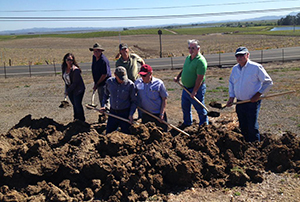 Grapegrowers participate in a groundbreaking ceremony at Acacia Vineyard to commemorate the start of a construction project that will link the Carneros AVA to Napa’s sewer treatment plant and carry recycled water for irrigation.
Grapegrowers participate in a groundbreaking ceremony at Acacia Vineyard to commemorate the start of a construction project that will link the Carneros AVA to Napa’s sewer treatment plant and carry recycled water for irrigation.Napa, Calif.—While the West Coast drought has been catastrophic for grapegrowers in some areas of California, it has had little impact on vineyards in other parts of the state. Comparing data about groundwater tables in various California grapegrowing regions highlights how different conditions can be.
First, the bad: Groundwater tables have plummeted in parts of the San Joaquin Valley and in Paso Robles on the Central Coast.
On the San Joaquin Valley’s west side, the water table plunged 400 feet in the early and mid-20th century due to pumping, but now it has dipped even lower. “Because of increased pumping, groundwater levels are reaching record lows—up to 100 feet lower than previous records,” said Mark Cowin, director of the California Department of Water Resources. This is a result of farmers pumping groundwater to replace missing surface water deliveries due to the drought.
READ MORE »
Top Stories
December 2015Mergers Continue for Major Distributors
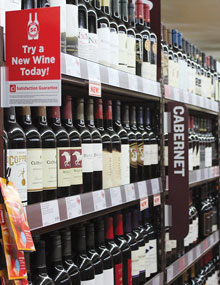 In light of the mergers of national wine distributors, more small producers are turning to specialty distributors, brokers and marketers.
In light of the mergers of national wine distributors, more small producers are turning to specialty distributors, brokers and marketers.Miami, Fla.—Amid talk about the mega-merger of two international beer giants and consolidation of retail chains, mergers of wine and spirits distributors continue to upend wine sales channels.
READ MORE »
Top Stories
November 2015Treasury to Buy Diageo Wine Brands for $552M
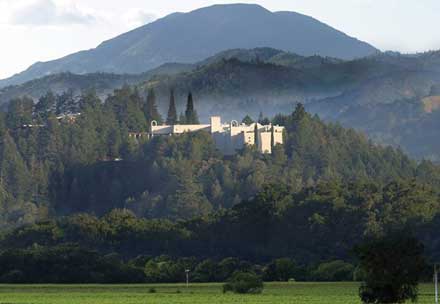 Sterling Vineyards is among the wine brands Treasury Wine Estates will purchase from Diageo Chateau & Estate Wines.
Sterling Vineyards is among the wine brands Treasury Wine Estates will purchase from Diageo Chateau & Estate Wines.Napa, Calif.—About a year after most assumed that Treasury Wine Estates (TWE) would be subject to an acquisition bid, the Australian wine company has turned around and is buying most of Diageo’s wine operations.
Diageo, the British drinks giant, has agreed to sell most of its U.S.-based Chateau and Estate Wines division—along with the U.K.-based Percy Fox business—to TWE for $552 million. The deal is expected to close around the end of the year and includes $48 million in capitalized leases.
“Wine is no longer core to Diageo, and this sale gives us greater focus,” Diageo CEO Ivan Menezes said Oct. 13 in a news release announcing the deal. “With the completion of this transaction, Diageo will have released £1 billion ($1.5 billion) from the sale of non-core assets since the start of the financial year.”
Headquartered in Napa, Calif., Diageo Chateau and Estate Wines includes Beaulieu Vineyard, Chalone Vineyard, Acacia Vineyard, Provenance Vineyards, Rosenblum Cellars and Sterling Vineyards.
Diageo is keeping the Chalone brand and assets and the Acacia facility and vineyard. The Acacia brand and the others will be acquired by TWE, which already owns Beringer Vineyards, Chateau St. Jean, Etude Wines, St. Clement Vineyards and Stags’ Leap Winery. TWE Americas operations also are based in Napa.
TWE gains Blossom Hill, which is one of the largest California wine brands in the U.K.
TWE’s American wine division had been the subject of buyout rumors since 2013, and two competing U.S. private equity groups tried to buy the company in September 2014. Their offers of around $3 billion, however, weren’t enough to convince CEO Michael Clark and shareholders to sell.
Clark’s plan for TWE has been to improve sales through its premium brands such as Beringer. The company just recently sold its sprawling Asti Winery and 275 acres of vineyards to E. & J. Gallo Winery for an undisclosed price.
Diageo is primarily a liquor business, and its wine sales accounted for only about 4% of the company’s total sales. The company’s key brands include Johnnie Walker (whisky), Tanqueray (gin), Captain Morgan (rum) and Guinness (beer).
In 2010, Diageo sold 17 of its Napa Valley properties for $269 million under a long-term leaseback deal with the option to extend those leases for up to 80 years.
TWE’s Clark said in a statement released by the company that the deal will be a “game changer” for the company’s U.S. brands and should enable it to become a much larger player in the premium wine segment.
READ MORE »
Top Stories
November 2015West Coast Harvest Numbers a Mystery
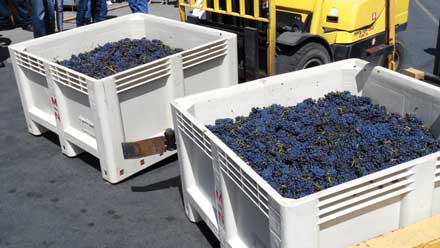 While the California wine grape harvest may be down 5%-15% from normal, some North Coast yields are down 25%, and Paso Robles reports a nearly 50% loss.
While the California wine grape harvest may be down 5%-15% from normal, some North Coast yields are down 25%, and Paso Robles reports a nearly 50% loss.Napa, Calif.—The 2015 California grape harvest is short, but it’s not clear how short. Estimates range from 50% or more off normal in parts of Paso Robles to just a little lower than average in some areas.
READ MORE »
Top Stories
October 2015Fires Devastate California Wine Regions
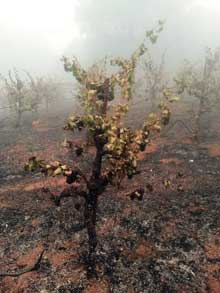 Kevin and Theresa Locke's 5-acre Mountain Ranch Vineyard was lost during the Butte Fire.
Kevin and Theresa Locke's 5-acre Mountain Ranch Vineyard was lost during the Butte Fire.Middletown, Calif.—Less than two months after the massive Rocky Fire burned 70,000 acres in California’s Lake County, located just north of Napa and Sonoma counties, the even more devastating Valley Fire burned an additional 70,000 acres, destroyed 585 homes and forced as many as 13,000 people to evacuate many small towns.
READ MORE »
Top Stories
October 2015California Harvest Comes in Fast and Light
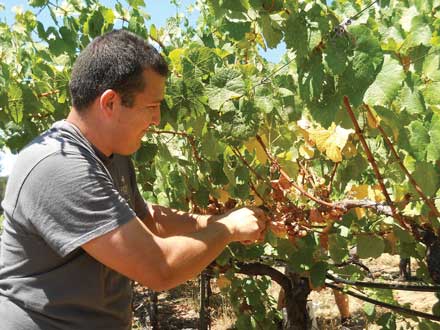 Husch Vineyards reported that white wine grape yields were down 30% in 2015.
Husch Vineyards reported that white wine grape yields were down 30% in 2015.San Rafael, Calif.—In mid-September, as Wines & Vines went to press, the 2015 wine grape harvest in California was halfway done in some regions and wrapping up in others, concluding a harvest that was widely described as quick and light.
From Mendocino County down through the Central Coast, most California growers and vintners said harvest came about three weeks early or sooner, and yields were down 20% to 30%, on average.
On Sept. 14, Zac Robinson, the co-owner of Husch Vineyards and member of the board of directors for the Mendocino WineGrowers, told Wines & Vines that the white wine grape harvest was pretty much done countywide. He said the white grape yields could be down 30% or more from the average. “The verdict is still out on the reds,” he said. “Pinot in Anderson Valley is varied—although that doesn’t mean much from a region where 3.5 tons per acre is considered ‘heavy.’”
He said the picking of Cabernet Sauvignon and Zinfandel was well under way throughout the county, which is home to more than 50,000 acres of vines, and yields looked OK. While the 2015 harvest came early, Robinson said the year wasn’t that abnormal.
“If you ignore the calendar for a moment, it actually looks like a very normal growing season,” he said. “The vines progressed nicely, and the weather was favorable until the very end. Of course, everything was shifted three weeks forward, but can’t we argue this was a calendar problem, not a Mother Nature issue? Perhaps the rains will arrive three weeks early too?”
In late July, John Balletto, the founder and owner of Balletto Vineyards and Winery in Santa Rosa, Calif., said he expected yields to be down 10% to 15%, but about a month later, he said it was more like 30% to 40%. Balletto farms more than 600 acres of vineyards in the Russian River Valley, and he said he heard similar crop yields from his neighbors. “There’s some big names out there looking for grapes,” he said at the time.
From far west Sonoma County, Jasmine Hirsch, director of sales and marketing for Hirsch Vineyards, located near the town of Cazadero, Calif., said the winery picked the last of its estate grapes Sept. 7, which is usually when harvest begins. “The yields this year are painfully low, about 65% below average,” she wrote in an Instagram post. “The quality could be extraordinary; the wines will be high in acid with intense fruit and great concentration. But there will be very little of them.”
Steve Matthiasson of Premiere Viticulture Services and Matthiasson Wines finished picking grapes for his own wines Sept. 14, which he said he was extremely early. “It’s nuts,” he said. “I have one lot of purchased fruit coming from the Foothills tomorrow, and our late-harvest wine, and that’s it.”
Matthiasson said it appeared yields were down 20% to 30% in general, but there was little to complain about when it came to the condition of the grapes. “Quality seems to be outstanding: high acids, extraordinarily deep color, easy extraction, soft but ample tannins, ripeness at lower sugar levels.”
He estimated that the Napa Cabernet harvest in general was about 15% complete at the time.
Vintners in the Sierra Nevada foothills also reported it was a small and early harvest, yet fruit quality was still good. Scott Klann, winemaker/proprietor of 5,000-case Newsome-Harlow Wines in Murphys, Calif., said harvest began Aug. 4. He had anticipated that yields would be down 30% to 50%, “But in reality it is shaping up to be only about 10% to 20% down,” he said. “Cluster size is tending to be about average up here in the Foothills.” Brix levels are higher than typical, “But speed of ripening is allowing us to hold on to acidity a bit.”
At 6,000-case Twisted Oak Winery, owner Jeff Stai said the first fruit (Verdejo) was harvested in early August. “It’s not exactly all at once, but it seems like it,” he said. Stai also reported “some” labor shortages during harvest.
“We’ve had some mildew issues, and cluster sizes are smaller,” he said. “We also had a poorly timed rain that caused some shatter.”
In Santa Barbara County, home to 249 wineries: “Harvest began on Aug. 3, earliest on record,” said Brooks Van Wingerden, general manager of 11,000-case Margerum Wine Co. “It is a very compact vintage due to the drought and warm weather, with low yields. Varieties that traditionally ripen at different times are ripening at the same time.”
Van Wingerden noted that warmer than usual water temperatures in the Pacific Ocean caused a lessening of diurnal temperature changes and nights that never cooled down.
Although Margerum’s grape volume is down some 40%-60%, and despite the weakened diurnal changes, Van Wingerden enthused, “Quality has been phenomenal: tiny clusters of intensely colored, incredibly flavored grapes.
Syrah and “a little Grenache” kicked off the 18,000-case Halter Ranch harvest on Aug. 20, according to winemaker Kevin Sass. Initial impressions of the fruit indicated inconsistencies and non-uniform ripening. “As a result we have spent more time on the sorting table, removing green berries within the clusters,” Sass said. A long, drawn out fruit bloom/set period resulted in a lack of uniformity during the set.
The Monterey County Vintners & Growers Association reported Aug. 21 that the crop was moving in about two weeks earlier than usual and was expected to be 20% to 40% smaller than recent large vintages, due to “unusual weather patterns and the ongoing effects of the drought.”
In the Livermore Valley, Las Positas Vineyards (3,000 cases), started picking Pinot Gris on Aug. 19, two weeks earlier than normal, according to winemaker Brent Amos. “Yields are down considerably, about 40% less than normal, mainly due to it being cooler than normal during fruit set. Harvest will likely end in mid-October, but it’s too early to tell for sure. Clusters are lighter because of poor fruit set. Brix and acid are normal this year (so far),” he said.
READ MORE »
Top Stories
September 2015Wine Institute Fires Back at Illinois Lawsuits
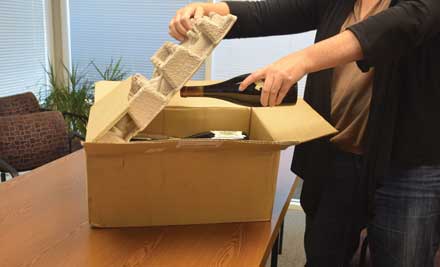 Wineries should be wary of shipping to Illinois, where an attorney is exploiting a tax loophole to collect tax penalties paid to the state.
Wineries should be wary of shipping to Illinois, where an attorney is exploiting a tax loophole to collect tax penalties paid to the state.Chicago, Ill.—Some lawyers chase ambulances in search of dollars. Others target wineries.
READ MORE »
Top Stories
September 2015West Coast Growers Report Earliest Harvest
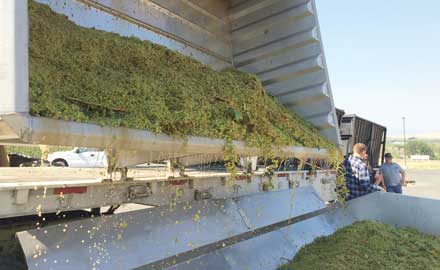 Treveri Cellars of Wapato, Wash., unloads 18 tons of Chardonnay for sparkling wine Aug. 7, the earliest harvest ever recorded in Washington state.
Treveri Cellars of Wapato, Wash., unloads 18 tons of Chardonnay for sparkling wine Aug. 7, the earliest harvest ever recorded in Washington state.San Rafael, Calif.—For many winemakers and grapegrowers in the western United States and Canada, the 2015 harvest came early, very early.
READ MORE »
Top Stories
August 2015California Growers Expect Smaller Yields; Large Inventory of Bulk Remains
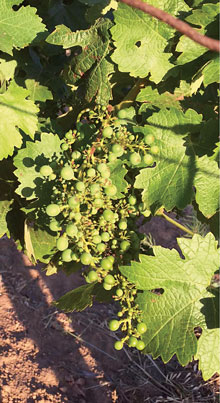 Several vineyards in Napa County Calif., suffered shatter because of cooler weather, pests and some light June rain.
Several vineyards in Napa County Calif., suffered shatter because of cooler weather, pests and some light June rain.San Rafael, Calif.—In the early spring, it appeared as if this year’s harvest in California might be wrapping up by the middle of September, as another warm winter triggered early bud break, prompting vines to push much earlier than normal.
Thanks to a cooler-than-normal May and unsettled weather in June, however, the reports of an early harvest are now being replaced with a sense of things returning to normal—or just a week or two early.
Some areas also experienced problematic set and cluster development because of windy, wet weather that also raised the risk of Botrytis and mildew—especially for later in the year. A couple of weak, low-pressure systems that came through the state around the Fourth of July brought more humidity and some thundershowers as well.
The Napa Valley Grapegrowers (NVG) reported in mid-June that a lengthy bloom period had created a “wide variability” in developing clusters. “Because of the variability in this year’s fruit set, crop thinning at the time of véraison will be even more important to even out the maturity of the clusters,” said Allison Cellini, NVG member and viticulturist at Cliff Lede Vineyards.
Eric Pooler, who oversees nearly 300 acres in Sonoma and Napa counties as the director of winegrowing for Boisset Family Estates, said 2015 is shaping up to be 10% to 25% lighter than previous years, depending on appellation and varietal. He said some severe shatter that reduced potential yields by more than 50% occurred in later blooming vineyards. “Although clusters are still starting to fill in, cluster structure is open and berry size is variable,” Pooler said.
At Gloria Ferrer in the Sonoma County side of the Carneros AVA, the lengthy bloom period did cause some shatter in blocks of Pinot Noir vines, but nothing significant. Winemaker Steven Urberg reported in July that everything looked good as the vineyard team worked to thin out the early crop and the clusters started véraison. “Coming off two large harvests, we have been extra careful this year to drop fruit to keep the crop load where we want it to produce the best quality,” he said. Weather can always change the situation, but Urberg estimated the first pick for sparkling wine would take place July 31.
Two of California’s most important growing regions, the North Coast and Central Valley, are moving in completely opposite directions. Prices continue to rise for grapes from Napa, Sonoma, Lake and other North Coast counties but have been plummeting in the interior.
“Last year we sold fruit (for) as low as $150 per ton in the San Joaquin Valley (SJV), up to $6,000 per ton in the North Coast.…Wineries are not buying SJV wine grapes at this time, and if they are talking, it’s not at prices that are sustainable for growers to continue farming wine grapes,” said Nat DiBuduo, president of the Allied Grape Growers, at the group’s annual meeting held July 9 in Santa Rosa, Calif.
Growers planted a few years ago when prices were high—some of them without contracts. “Today we are seeing contracts expire and not renewed. Wineries are indicating they are still dealing with a backload of bulk wine and plenty of contracted grapes.”
As a result, many growers are selling or pulling out their vineyards. One important factor is the strong demand for land suitable for nut crops in the San Joaquin Valley. DiBuduo said, “We believe up to 35,000 acres of grapes may be removed in 2015 for this reason, and two-thirds will be wine grapes.”
Steve Dorfman, a partner and trader with the Novato, Calif. based wine and grape brokerage The Ciatti Co., also remarked on the disparity between the North Coast and the San Joaquin Valley. The most recent Ciatti newsletter about the market referenced a “hangover of aging wine” that remains “a big problem for the California wine industry.”
That hangover is unsold, value-priced wine from the San Joaquin Valley, Dorfman said. Much of this wine came from the recent big harvests and consumer demand hasn’t grown in step with the excess production. The “pie” of available wine is just a little too big for the market.
Turrentine Brokerage president Steve Fredricks told Wines & Vines in mid-July that he thought the current bulk market was still around 20 million gallons, with perhaps just slightly more getting sold than added. He said wineries and other buyers are seeking quality wine to sell at retail for more than $10 per bottle.
Yields likely will be lower this year, but that will be offset by new acres, Fredricks said. He added there’s a good amount of coastal wine available on the bulk market as well, so a smaller harvest won’t affect the overall wine and grape market too much. “Because of the last few years people have been feeling like their inventory is an asset,” he said.
Fredricks said he’s a little surprised by the continuing strength of Napa County Cabernet Sauvignon, but he added one trend that’s been reversed from last year is demand for North Coast Cabernet in general is not as strong.
READ MORE »
Top Stories
August 2015Rapid Growth Prompts Sale of Meiomi Brand
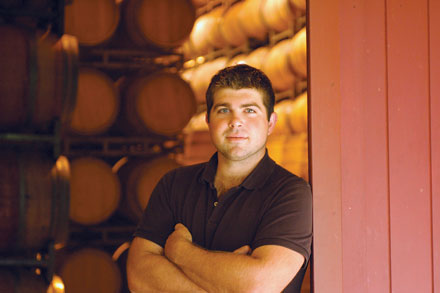 Joe Wagner sold his brand Meiomi to Constellation for $315 million.
Joe Wagner sold his brand Meiomi to Constellation for $315 million.St. Helena, Calif.—The young winemaker who recently agreed to sell the Meiomi brand of California wine to Constellation Brands for $315 million said the transition came at a time when his company faced a high hurdle: continuing to make enough wine to fill fast-growing demand as production surpassed 500,000 cases.
READ MORE »
Top Stories
July 2015The Wine Group Moves Upscale
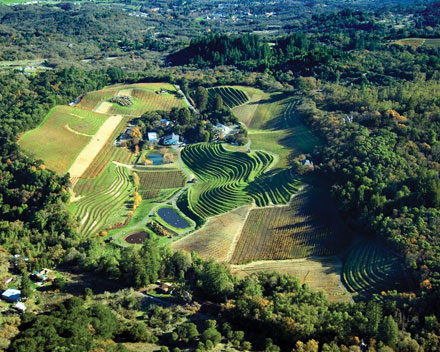 The Benziger Family Winery sale included its 85-acre Biodynamic vineyard.
The Benziger Family Winery sale included its 85-acre Biodynamic vineyard.Glen Ellen, Calif.—When The Wine Group, the second-largest U.S. wine company, acquired Benziger Family Winery and Imagery Winery in Sonoma Valley on June 8, some members of the trade felt luxury brands were not a natural fit in The Wine Group’s portfolio.
READ MORE »
Top Stories
July 2015Wine Racket Leads to Charges in Canada
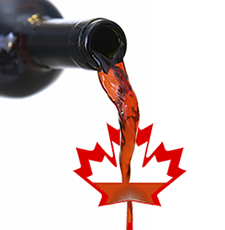 Montreal prosecutors allege that nearly 4.28 million gallons of imported bulk wine were doctored and sold as part of an underground scheme in Quebec, Canada.
Montreal prosecutors allege that nearly 4.28 million gallons of imported bulk wine were doctored and sold as part of an underground scheme in Quebec, Canada.Montreal, Quebec—A preliminary hearing in the criminal trial of one of the Canada’s biggest cases of wine fraud will be set this fall after more than a year of investigation.
READ MORE »
Top Stories
June 2015Northwest Growers Strategize to Face Drought
 All of Oregon and much of Washington state are experiencing low water levels.
All of Oregon and much of Washington state are experiencing low water levels.Yakima, Wash.—Water stopped flowing to irrigation canals in the Roza Irrigation District in mid-May, putting Yakima Valley grapegrowers on the front lines of an emerging drought scenario in the Northwest.
April saw Oregon Gov. Kate Brown add three counties to the list of 13 counties in her state facing a drought emergency (some entering their fourth year), while Washington Gov. Jay Inslee declared drought emergencies in three areas of the Evergreen State.
The past winter delivered record low snowpacks across the Northwest, with the spring snowpack dropping below levels seen in 2005, when drought was also widespread. The latest reports indicate Oregon’s snowpack was just 11% of normal May 1, while Washington state reported a snowpack just 16% of normal as of May 11.
Now, water has been shut off to canals in the Roza district as officials implement water-conservation plans standard in drought emergencies. A typical shut-off lasts upwards of three weeks.
While most irrigated districts in the Yakima Valley AVA enjoy senior water rights that guarantee them 3 acre feet of water per year, the Roza has junior water rights to service 72,000 acres of agricultural land including upwards of 12,000 acres of vineyard. This places it first in line for cuts when drought strikes; this year, the district anticipates a 50% cut in its water allotment. It has therefore cut the flow to its 545 miles of canals and will likely do so again in September.
This isn’t necessarily devastating to grapegrowers, said Wade Wolfe of Thurston Wolfe Winery in Prosser, Wash. “Wine grapes in the Yakima Valley require about 1 to 1.5 acre feet of supplemental water to produce a full crop, and even with a 50% allocation there should be enough water,” he told Wines & Vines.
Anticipating the shut off in the wake of the governor’s announcement of a drought emergency in April, growers will have drawn off water to ensure the soil has the moisture it needs, Wolfe said.
Most growers practice regulated deficit irrigation during the summer, but if the district shuts off water to irrigation canals again in September—as part of its drought response— some may modify their irrigation regime to bring in a bit more water prior to harvest. “In anticipation of the water being turned off early, they will likely alter (their) practice to supply additional water prior to harvest,” Wolfe said.
This is in keeping with the consensus of a panel at the Washington Association of Wine Grape Growers convention this past February, which concluded that deficit irrigation is best practiced early in the season. “Assuming a typical growing season, there should be adequate water for the wine grapes,” Wolfe said.
But as with all matters associated with water, it pays to read the fine print.
Wine grape producers often farm more than just grapes, meaning some may decide to divert water from a portion of their acreage for vineyard use; others, with properties enjoying senior water rights, may tap those rights to use their entitlement on less entitled properties.
The district, as well as individual growers, also has the ability to purchase water from senior rights holders.
While transferring rights is seldom a simple matter, especially in drought years, the strategy factored into the Den Hoed family’s purchase of an 80-acre property in the upper Columbia River Basin in 2008. However, the system aims to keep overall extractions level—and, in the current environment, conservation-oriented.
A reduced snowpack will mean less run-off, and that ultimately impacts aquifers, but sources contacted by Wines & Vines reported wells are in good shape. A sudden rainfall in mid-May delivered 2 inches of rain in some parts of Eastern Washington, too. The recent rain has muted the impact of drought declarations across the Northwest for many growers.
“We don’t see any significant problems for wine grapegrowers in the Walla Walla Valley,” said Duane Wollmuth of the Walla Walla Valley Wine Alliance. “Most of our irrigation comes from deep basalt wells, which at this time are in good shape.”
The drought spreading across Washington and Oregon has yet to reach British Columbia. While the province reported its lowest average snowpack in 31 years, the westernmost province is living up to Canada’s moniker of “the Great White North” with an average snowpack the envy of its southern neighbors. While the snowpack in the province’s southwest region is extremely low, with Vancouver Island reporting a snowpack just 14% of normal, the Okanagan snowpack was estimated at 57% on May 1,
READ MORE »
Top Stories
June 2015Diageo Reportedly Tries to Sell Brands Including BV, Sterling
 Sterling Vineyards is set on a knoll in Calistoga.
Sterling Vineyards is set on a knoll in Calistoga.London, England—Many reports from the United Kingdom say Diageo, the British alcohol beverage giant, has put up its wine brands for sale.
They include premium Beaulieu Vineyard, Sterling Vineyards, Acacia Vineyard and Provenance Vineyards, plus lower end Blossom Hill, reportedly the largest California wine brand by volume sold in the United Kingdom.
The company isn’t talking, nor are the brokers likely to be charged with selling or managing any transactions.
Wine represents only 4% of the Diageo portfolio, and it is less profitable than the company’s large volume spirits and beer brands. Guinness brewing lies at the heart of the company.
Other major wine companies such as E. & J. Gallo, Trinchero Family Estates and Constellation Wines are also beefing up their spirits (and beer) portfolios. Gallo is already the largest U.S. brandy producer (Paul Masson), and the others have been adding tequila and other popular spirits.
Diageo sold 17 of its prime Napa Valley real estate holdings, including Beaulieu and Sterling wineries (along with 400,000 square feet of production, retail and hospitality space connected to the two wineries) and 2,000 acres of vines to Realty Income Corp. in 2010 for $269 million under a long-term, triple-net leaseback agreement. A 20-year lease gives Diageo the option to extend the lease for up to 80 years.
Though Diageo sold the two iconic wineries, the company continues to manage and operate the properties and retain “ownership of the brands, vines and grapes, which remain a strategic part of Diageo’s wine business,” a news release stated at the time of sale. Ownership of the vines doesn’t include the land, however.
The sale occurred after a review of business that “resulted in a reduction in the workforce and may also include the sale of non-strategic brands,” according to the statement, which added, “The benefit to free cash flow in the year ending June 30, 2010, is expected to be in the region of $200 million. The transaction will also improve the return on invested capital of the Diageo Chateau & Estate Wines business.”
Acacia Vineyard in Carneros and Provenance Vineyards in Rutherford (both in Napa County, Calif.), as well as Chalone Vineyards in Monterey County, Calif., and the large Blossom Hill production facility and vineyards in San Benito County (also owned by Diageo) were not affected by the deal in 2010.
Provenance occupies a high-visibility location on Highway 29 in the Napa Valley, and it could be a prime catch for a wine company seeking a presence there.
Realty Income Corp., based in Escondido, said at the time it anticipated that Diageo would become its second-largest tenant, generating 5.7% of its total revenue, or $327.6 million. With growth in RIC’s portfolio during 2014, the Diageo operations dropped to 2.6% of its portfolio.
An attorney who is involved in many of RIC’s deals said that a buyer of the winery brands would likely assume the lease.
Beaulieu Vineyard in Rutherford (called BV locally) was one of the wineries that built Napa Valley’s reputation along with nearby Inglenook Vineyards. Sterling Vineyards, built in the style of a monastery on a knoll in Calistoga and reached via a gondola, remains perhaps Napa Valley’s most dramatic setting.
Georges de Latour and his wife Fernande established Beaulieu in 1900. The winery was bought by international conglomerate Heublein Inc. in 1969, and Heublein was acquired by RJR Nabisco, then sold to Grand Metropolitan in 1987. Grand Metropolitan became Diageo in 1997 through a merger with Guinness Brewery.
English expatriate Peter Newton founded Sterling in 1964, selling it to the Coca-Cola Co. in 1977. Seagram bought the winery in 1982 and was in turn purchased by Diageo in 2001.
READ MORE »
Top Stories
May 2015California Governor Spares Ag From Mandatory 25% Water Cuts
Sacramento, Calif.—With the smallest snowpack ever recorded and no end to the drought in sight, California Gov. Edmund (Jerry) G. Brown Jr. announced actions intended to save water, increase enforcement to prevent wasteful water use, streamline the state’s drought response and invest in new technologies to make the state more drought resilient.
For the first time in state history, the governor has directed the State Water Resources Control Board to implement mandatory water reductions of 25% in California cities and towns.
This savings amounts to approximately 1.5 million acre-feet of water over the next nine months, or nearly as much as is currently in Lake Oroville.
To save more water now, the order will also:
READ MORE »
Top Stories
May 2015Lawsuit Threatens Wineries' Reputations
Los Angeles, Calif.—Alopecia, anorexia, ataxia—these are hardly the characteristic physical attributes of those who frequent tasting rooms and wine shows, let alone the 13% of the population marketers term “high-frequency wine consumers” who drink wine several times a week or even daily.
READ MORE »
Top Stories
April 2015West Coast Port Slowdown Hinders Wine Industry
 The Port of Oakland is among West Coast ports experiencing significant delays.
The Port of Oakland is among West Coast ports experiencing significant delays.Oakland, Calif.—After working without a contract for seven months, dockworkers at 29 West Coast ports breathed a sigh of relief Feb. 20, when labor negotiators reached a tentative working agreement. But many suppliers serving the wine industry are still waiting for their shipments to be delivered, and laborers have yet to vote on the proposed contract, opening a window of possibility for further delays.
READ MORE »
Top Stories
April 2015Buds Point to Another Early Year
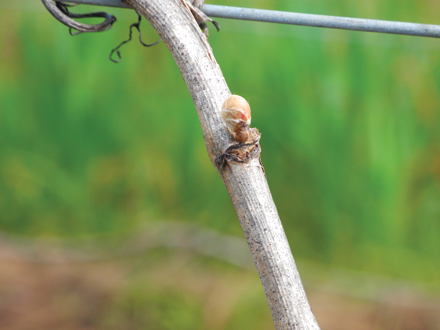 Chardonnay buds start to swell at Crawford Beck Vineyard in Amity, Ore.
Chardonnay buds start to swell at Crawford Beck Vineyard in Amity, Ore.San Rafael, Calif.—From California to British Columbia, vines are beginning to wake in vineyards across much of the West Coast, and 2015 is shaping up to be another early vintage.
READ MORE »
Top Stories
March 2015California 2014 Crop Large, No Record-Breaker
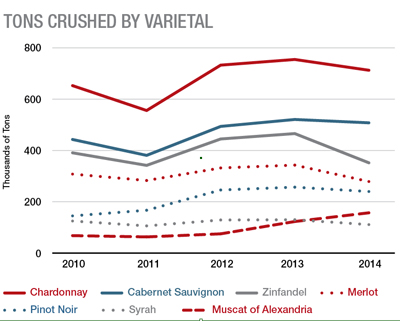 Source: USDA National Agricultural Statistics Service
Source: USDA National Agricultural Statistics ServiceSacramento, Calif.—After two boom years, California’s wine grape harvest shrunk 7.9% to 3.91 million tons, following the record 2013 crush of 4.25 million tons. The USDA’s National Agricultural Statistics Service released the Preliminary Crush Report on Feb. 10, revealing interesting trends but few real surprises for wine industry professionals who study the wine and grape markets year-round.
READ MORE »
Top Stories
March 2015Unified Tells a Tale of Two Wine Markets
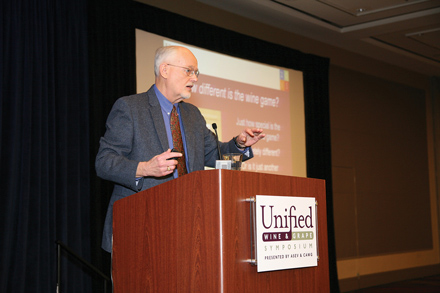 Economist Mike Veseth speaks during the State of the Industry at the Unified Wine & Grape Symposium.
Economist Mike Veseth speaks during the State of the Industry at the Unified Wine & Grape Symposium.The Unified Wine & Grape Symposium held in late January in Sacramento, Calif., highlighted the divergence of the wine market, with one half struggling as the other prospers.
READ MORE »
Top Stories
February 2015With Massachusetts Now Open, 90% of U.S. Consumers Can Buy Wine Direct
San Francisco, Calif.—With Massachusetts, the nation’s seventh largest market for wine, open for direct shipping, 90% of the American population located in 42 states can, with some limitations, receive direct shipments of wine from bonded wineries.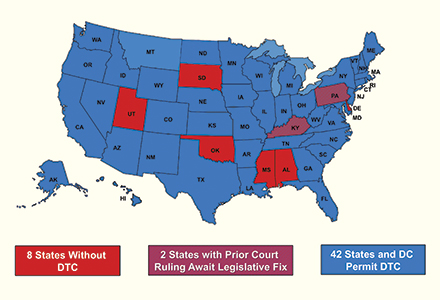 DTC Shipping by Wineries as of January 2015.READ MORE »
DTC Shipping by Wineries as of January 2015.READ MORE »
Top Stories
February 2015DtC Shipments Grow 15% in 2014 as Oregon Wines Surge
Concord, Calif.—Wine shipments from U.S. wineries to consumers across the country hit all-time highs in value and volume in 2014, according to the 2015 Direct to Consumer Wine Shipping Report created by ShipCompliant and Wines & Vines. The value of these DtC shipments surpassed $1.8 billion, more than 15% above the 2013 total. Volume grew almost as quickly, reaching 3.9 million cases.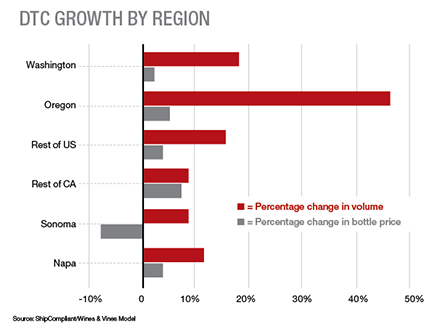 READ MORE »
READ MORE »
Top Stories
January 2015Tough Market for San Joaquin Grapes; Almonds an Attractive Option
Growers in the San Joaquin Valley of Central California reported low prices for non-contract grapes during harvest 2014.Fresno, Calif.—The weak wine grape market that has growers in the San Joaquin Valley concerned was the result of multiple factors that converged this vintage.
READ MORE »
Top Stories
January 2015Rain Encourages Growers Though Drought Remains
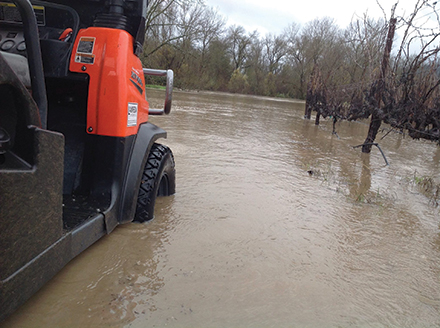 Mendocino County, Calif., got 10.85 inches of rain between Dec. 1 and Dec. 18.
Mendocino County, Calif., got 10.85 inches of rain between Dec. 1 and Dec. 18.Napa, Calif.—The heavy storms that hit California in mid-December won’t end the drought, but they will certainly help: “Before the rainy pattern takes a break, cumulative rainfall will have taken a huge slice out of the long-term drought,” said AccuWeather.com meteorologist Alex Sosnowski.
READ MORE »
Top Stories
January 2015Obama Immigration Plan Gets Tepid Response From Wine Industry
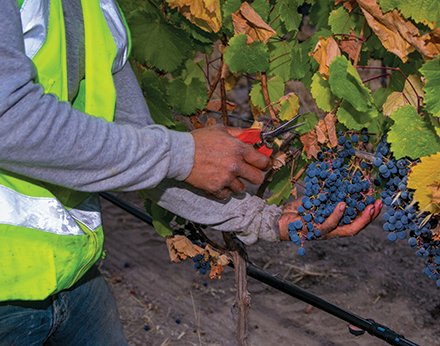 The high cost of living in California makes it a difficult place to live for many immigrants working in the agriculture sector.
The high cost of living in California makes it a difficult place to live for many immigrants working in the agriculture sector.Washington, D.C.—The Nov. 20 announcement of U.S. president Barack Obama’s executive order for immigration reform was welcomed but deemed insufficient by many wine/vineyard organizations—and the attorneys who serve them. Republicans in the U.S. House of Representatives, meanwhile, have voted to roll back the executive order.
READ MORE »
Top Stories
December 2014This Month in Perspective
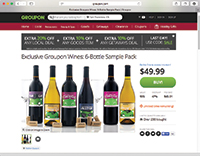
Groupon debuts private label
READ MORE »
Top Stories
November 2014Wineries Wary After Big Fine for Allowing Volunteer Labor
An enthusiastic wine club member seals his own bottle of dessert wine at Westover Winery in 2013.Castro Valley, Calif.—California seems to be paying more attention to laws that restrict volunteer grape pickers and other labor.
READ MORE »
Top Stories
November 2014Challenges Don't Stop Strong West Coast Harvest
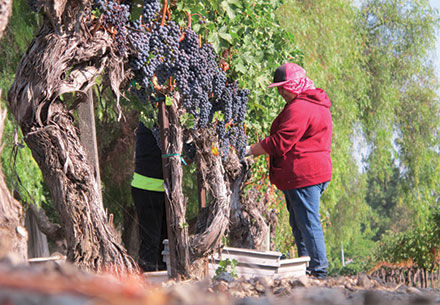 A vineyard worker harvests red wine grapes at Retzlaff Vineyards & Winery in Livermore, Calif.
A vineyard worker harvests red wine grapes at Retzlaff Vineyards & Winery in Livermore, Calif.San Rafael, Calif.—As harvest wraps up in California and other grapegrowing regions along the West Coast of North America, early reports describe the 2014 vintage as early but with good quality and average to record yields.
READ MORE »
Top Stories
October 2014Earthquake Demonstrates Barrel Stack Vulnerability
Trinchero Napa Valley winery uses Australian-made racks from RGB Industries that don't rest on the barrels when stacked to provide more stability in the event of an earthquake.Napa, Calif.—The enduring image of the Napa earthquake will likely be the piles of barrels and racks from toppled barrel stacks.
READ MORE »
Top Stories
October 2014Financial Impact of Quake Rises
Napa, Calif.—Following the earthquake centered south of the city of Napa on Aug. 24, Napa County officials estimated that wine companies sustained $48 million in damages, but they warned the total could rise as more information was collected.
READ MORE »
Top Stories
October 2014New York OKs Out-of-State Grapes
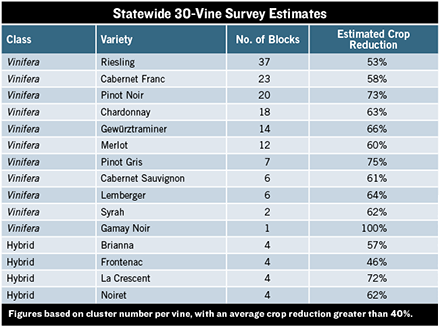 Source: Cornell Cooperative Extension
Source: Cornell Cooperative ExtensionAlbany, N.Y.—From Iowa to New England, the winter of 2014 was unusually cold. New York was no exception, and it endured a series of low-temperature episodes in January and February that resulted in significant bud injury in many vineyards. Cold-sensitive vinifera grape varieties were damaged across the state, and the extreme cold affected even cold-hardy northern varieties such as the Minnesota and Cornell hybrids grown in the Thousand Islands region of northern New York. The table “2014 Winter Injury” shows the low temperatures during the past winter in three regions in New York.
READ MORE »
Top Stories
September 2014Treasury May Finally Be Sold--And Likely Dismembered
 Beringer is the largest North American winery owned by Treasury Wine Estates.
Beringer is the largest North American winery owned by Treasury Wine Estates.Victoria, Australia—After years of speculation, it looks like Australia’s troubled Treasury Wine Estates may get a new owner.
READ MORE »
Top Stories
September 2014Drought Worsens Despite Rare August Rain
Nearly 100% of California met parameters for severe drought when the Climate Precipitation Center released its Drought Monitor on Aug. 12. Source: Richard Tinker / CPC/NOAA/NWS/NCEPSacramento, Calif.—As federal officials note in the most recent report on drought conditions in the United States: “A strange thing happened on the path to California’s historic drought: It rained.”
READ MORE »
Top Stories
August 2014Wineries May Lose Dispute Over Internet Domains
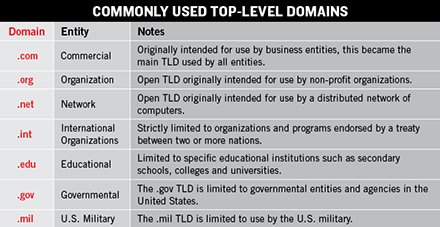
Marina del Rey, Calif.—It appears that wine companies may suffer collateral damage in a policy dispute between European agencies and the United States over control of the Internet.
READ MORE »
Top Stories
August 2014Massachusetts Approves DtC Law, Opens State to Wine Shipping
Boston, Mass.—With persistent political and legal pressure and a little celebrity stardust from a former NFL quarterback, efforts to open Massachusetts to wine shipping paid off July 11, when Gov. Deval Patrick signed into law a state budget that includes a provision allowing direct shipments of wine to residents.
READ MORE »
Top Stories
August 2014California Races Toward Harvest
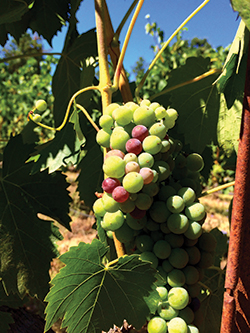 Véraison hit Rivino Winery July 10.
Véraison hit Rivino Winery July 10.Veraison came a good week early for Jason McConnell, owner of Ukiah, Calif.-based Rivino Winery. The Mendocino County winemaker said he noticed Sangiovese berries start to change color July 10.
READ MORE »
Top Stories
August 2014Questions for Treasury Wineries Continue
San Rafael, Calif.—Speculation and rumors continue to surround Treasury Wine Estates (TWE), which is fighting a lawsuit by Australian shareholders, has made leadership changes and is laying off workers.
READ MORE »
Top Stories
August 2014Grapegrowers Association Calls for Better Grape Acreage Data
Fresno, Calif.—Grapevines are being planted in California vineyards based on faulty information, according to Nat DiBuduo, president/CEO of Allied Grape Growers (AGG), which represents nearly 600 grower-members throughout California. DiBuduo said, “NASS does a great job, but the acreage is underreported.”
READ MORE »
Top Stories
August 2014Packaging Conference Set for Aug. 20 in Napa
Napa, Calif.—Winemakers, winery executives, operations managers and marketers will have the opportunity to immerse themselves in the fast-changing subject of wine packaging at the Wines & Vines Packaging Conference on Aug. 20. Magazine staff designed the one-day event, which will be held in the former Copia building in Napa, to educate winery personnel about packaging innovations through expert presentations, formal tastings and the ability to touch the latest bottles, labels, closures, capsules and cartons.
READ MORE »
Top Stories
July 2014Labor Decline at Odds With Immigration Reform
The number of farm laborers in Mexico declined by nearly 2 million between 1995 and 2010. Photo: Agricultural and Resource Economics UpdateSan Rafael, Calif.—With mid-term elections looming in November, advocates for immigration reform are hoping that the U.S. House of Representatives can reach an agreement on legislation this summer. An expert in agricultural economics, however, contends any immigration reform law would be a short-term measure that can’t change one simple but important reality: There are fewer immigrants seeking farm work in the United States.
READ MORE »
Top Stories
July 2014Grapevine Pests Discovered in Nursery Shipments
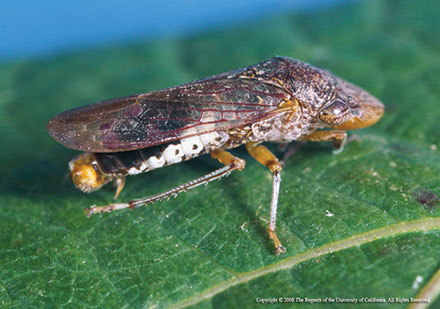 Glassy-winged sharpshooter spreads Xylella fastidiosa, the causal agent of Pierce's disease. Photo: Jack Kelly Clark/University of California
Glassy-winged sharpshooter spreads Xylella fastidiosa, the causal agent of Pierce's disease. Photo: Jack Kelly Clark/University of CaliforniaNapa, Calif.— On the morning of May 22, inspectors from the Napa County Agricultural Commissioner’s office discovered two viable glassy-winged sharpshooter egg masses during a shipment inspection at a local plant retailer. In addition to contacting the California Department of Food and Agriculture (CDFA), Napa officials notified authorities in other counties, and throughout the day at least five California counties identified glassy-winged sharpshooter (GWSS) eggs in shipments originating from the same plant broker in San Diego County, Calif.
READ MORE »
Top Stories
June 2014California Wine Cities Re-Using Wastewater
 Workers prepare a base slab for concrete at the Paso Robles Wastewater Treatment Plant in May. Matt Thompson, wastewater resources manager for Paso Robles, said recycling municipal wastewater is not a matter of ‘if,’ but ‘when.’ Photo from The Covello Group for the City of El Paso de Robles.
Workers prepare a base slab for concrete at the Paso Robles Wastewater Treatment Plant in May. Matt Thompson, wastewater resources manager for Paso Robles, said recycling municipal wastewater is not a matter of ‘if,’ but ‘when.’ Photo from The Covello Group for the City of El Paso de Robles.Responding to continued anxiety about looming shortages of water to irrigate vineyards in this northern Sonoma County wine hub, the Healdsburg Utilities District announced it would make treated municipal wastewater available—for free. Spigots located near the city’s sewage treatment plant will be available to fill as many as 15 private tanker trucks daily for transportation to vineyard ponds for drip irrigation systems.
READ MORE »
Top Stories
June 2014Vineyard and Winery Acquisitions Continue
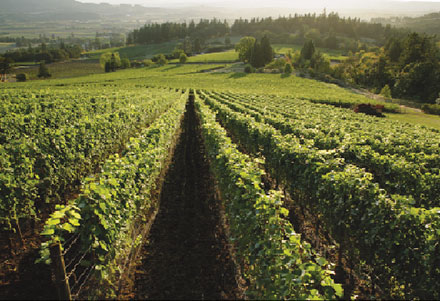 Adelsheim Vineyard recently purchased a 59-acre site that includes Bryan Creek Vineyard (above).
Adelsheim Vineyard recently purchased a 59-acre site that includes Bryan Creek Vineyard (above).As the race continues to assure grape supply to a perennially growing U.S. wine industry, so does the race among wineries buying vineyards. Meanwhile, acquisitions by large wine producers mean the “big guys” are getting even bigger. The sellers in at least three of the past month’s deals were elderly owners.
READ MORE »
Top Stories
June 2014Early Crop Estimates Higher Than Anticipated in California
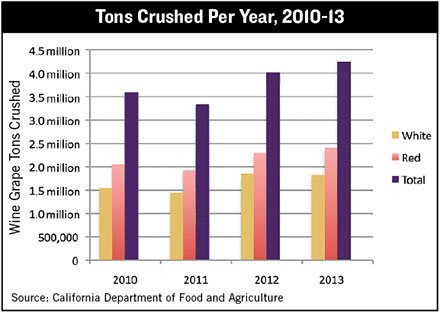
California could see an above-average wine grape harvest in 2014, according to early predictions coming from some California vineyards. A third consecutive large crop would be almost unprecedented—and surprising, given the drought concerns that have mounted this year and the assumption by many growers that grapevines naturally limit their fruit production after a big harvest.
READ MORE »
Top Stories
May 2014Starbucks to Offer Wine at More Locations
SEATTLE, WASH.—In an effort to build its evening business, coffee giant Starbucks is expanding wine and beer sales after 4 p.m. in selected stores. Though it’s starting slowly and the program affects only some of the chain’s locations, members of the wine industry are excited about the sales potential in the company’s 12,000 shops. Starbucks has hinted “several thousand” cafés may eventually serve wine.
READ MORE »
Top Stories
May 2014Brutal Winter in the East
ITHACA, N.Y.—The winter of 2013-14 brought bitterly cold temperatures to the upper Midwest, the mid-Atlantic region and New England. On March 26, the U.S. Department of Agriculture issued a natural disaster declaration for 19 counties in New York. Other states are working to obtain similar declarations so that growers can obtain financial assistance to replant or rehabilitate freeze-damaged vineyards.
READ MORE »
Top Stories
May 2014Northwest Vineyard Deals Reflect Rebound
PASCO, WASH.—The unprecedented wave of investment in Northwest vineyards and wineries in the past 18 months has been greeted by many as a vote of confidence in the region’s wine industry.
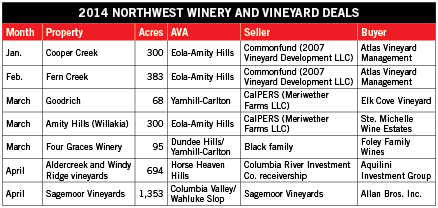
Washington state emerged as the leader in the latest round of transactions, with British Columbia’s Aquilini Investment Group adding 694 acres in the Horse Heaven Hills AVA to its holdings on the heels of 670 acres it acquired on Red Mountain from the Kennewick Irrigation District in November. Days later, Allan Bros. of Naches, Wash., paid an undisclosed sum to acquire Sagemoor Vineyards, which farms 883 acres of vineyards and 420 acres of tree fruits.
“I think if the industry had been doing poorly they probably wouldn’t have been looking at it,” said Kent Waliser, general manager of Sagemoor, noting that Allan Bros. did its due diligence regarding the vineyard’s contracts, customers and overall business model. “They liked how that looked, and they believe there’s a strong future in the wine industry.”
Allan Bros.’ desire to grow wine grapes mirrors diversification by other tree fruit growers including Zirkle Fruit Co. and Wyckoff Farms Inc. Its own acreage will give Sagemoor room to expand, while Sagemoor’s orchard acreage will also benefit Allan Bros. “They have a land base with some land that’s not planted to anything, and we’re going to start the process of strategically looking at where that land is and what it could grow best,” Waliser said.
The deal also addressed a long-standing need to resolve succession issues within Sagemoor.
Originally established by Alec Bayless and Winslow Wright in 1968 as a limited partnership, Wright is now 95 years old and Bayless’ interest is held by his widow, who is in her late 80s. The death of either partner could have led to the breakup of the company, something the sale to Allan Bros. avoids while ensuring a return to the 70 partners with a stake in the company. “Maybe in retrospect it will look like it was a great time to sell, but they weren’t trying to pick the market or pick the timing,” Waliser said.
Market rebounding from recession
READ MORE »
Top Stories
April 2014Treasury Appoints CEO as Earnings Drop
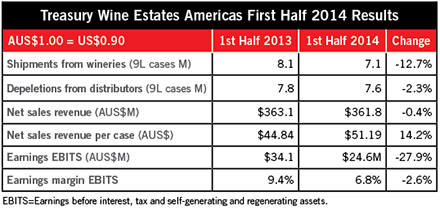
NAPA, CALIF.—Treasury Wine Estates made significant moves to address its poor financial performance, announcing the selection of a new CEO, a new VP of marketing for its Americas division and a new look for its Souverain label, among other moves.
READ MORE »
Top Stories
April 2014Eastern Wine Industry Economy Grows
LANCASTER, PA.—California may have the largest number of wineries in the United States, but there are wineries in all 50 states, and the industry is expanding every year.
With a total of 319 wineries, New York has more wineries than any other state east of the Mississippi River, and it produces nearly 20.4 million cases of wine per year. Of course, 17 million of those cases are made at Canandaigua Winery, one of the largest wineries in the country.
READ MORE »
Top Stories
April 2014Despite Rains, California Drought Continues
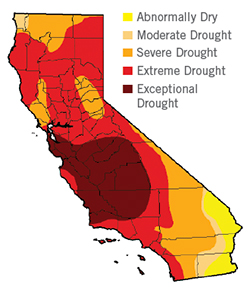
SAN RAFAEL, CALIF.—Thanks to some February and March rainstorms, cover crops were in full growth across California’s vineyards in mid-March, but the greenery belied the serious drought the state was experiencing.
READ MORE »
Top Stories
March 2014Rains Ease California Drought--Slightly
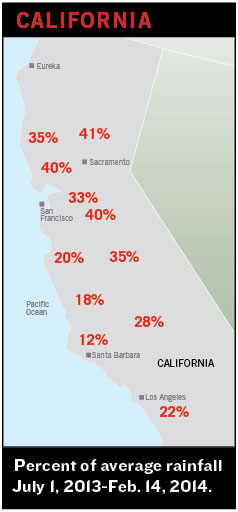
NAPA, CALIF.—More than 10 inches of rain fell in some areas Feb. 5-9, helping to ease the severe drought facing California grapegrowers. The rain fell mainly in the North Coast counties of Sonoma, Napa and Mendocino as well as the central Sierra Nevada, source of most of the water used by Central Valley growers.
READ MORE »
Top Stories
March 2014Record California Wine Grape Harvest
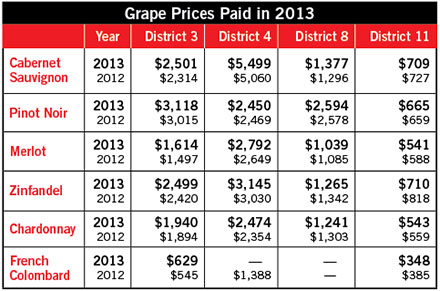 The Grape Crush Report cites District 3 as Sonoma and Marin counties, District 4 as Napa, District 8 as San Luis Obispo, Santa Barbara and Ventura counties and District 11 as San Joaquin County north of State Highway 4 and Sacramento County south of U.S. 50 and east of Interstate 5.
The Grape Crush Report cites District 3 as Sonoma and Marin counties, District 4 as Napa, District 8 as San Luis Obispo, Santa Barbara and Ventura counties and District 11 as San Joaquin County north of State Highway 4 and Sacramento County south of U.S. 50 and east of Interstate 5.SAN RAFAEL, CALIF.—California followed up the bumper harvest of 2012 with an even larger one in 2013. At 4.23 million tons, the state’s total yield was higher than analysts expected.
READ MORE »
Top Stories
March 2014New Farm Bill Adds Support for Grapes, Wine
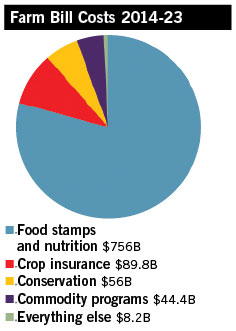
WASHINGTON, D.C.—Grapegrowing research and other programs to support the wine industry will receive increased funding from the Agricultural Act of 2014 (commonly known as the Farm Bill), signed Feb. 7 after four years of debate. The mammoth $956 billion act sets funding for five years for a broad sweep of agricultural interests including the Supplemental Nutrition Assistance (food stamp) Program, which it cut by $8 billion over the next decade.
READ MORE »
Top Stories
February 2014Fine Wine Sales to Grow But Profits Remain Depressed
Santa Clara, Calif.—On the heels of a good year for wine production and sales across much of North America, wine industry executives can look forward to continued growth, according to Silicon Valley Bank’s Rob McMillan. Releasing SVB’s annual State of the Wine Industry report in January, McMillan predicted that fine wine sales would grow between 6% and 10% this year—up from 4% to 8% in 2013.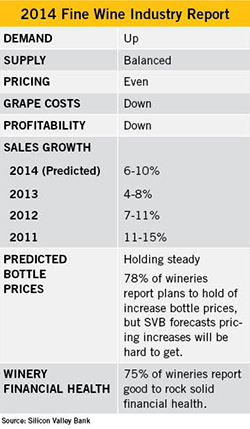 READ MORE »
READ MORE »
Top Stories
February 2014Frigid Winter Tough on Midwest and East
Lancaster, Pa.—Grapegrowers east of the Rockies often face cold winters. January 2014 reinforced that understanding, as temperatures Jan. 6-8 dropped to lows not experienced for two decades across the Midwest and into the East. Those low temperatures, accompanied by strong winds, came from a large pocket of very cold air known as a polar vortex, which normally sits over the polar region.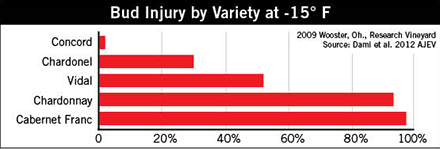 READ MORE »
READ MORE »
Top Stories
February 2014Sonoma Growers Aim for 100% Sustainability
Santa Rosa, Calif.—The Sonoma County Winegrowers on Jan. 15 announced their goal to certify all of the county’s nearly 60,000 acres of vineyards as sustainable within the next five years. No California county has accomplished this feat.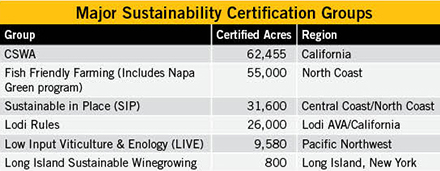 READ MORE »
READ MORE »
Top Stories
January 2014Duckhorn Deal Ends Year of Northwest Investment
Benton City, Wash.—When the Aquilini Investment Group of British Columbia on Nov. 23 bid $8.8 million (including buyer’s premium) for 670 acres that the Kennewick Irrigation District was offering in the high-priced grape-growing district of Red Mountain, tongues started wagging.READ MORE »
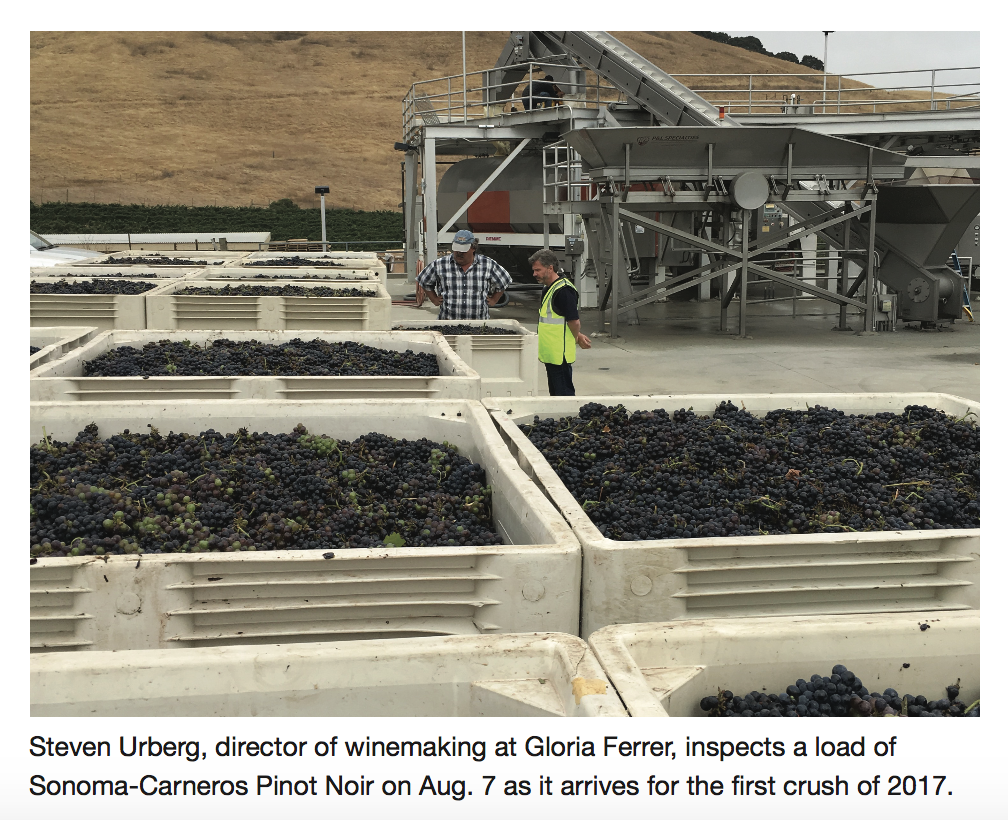
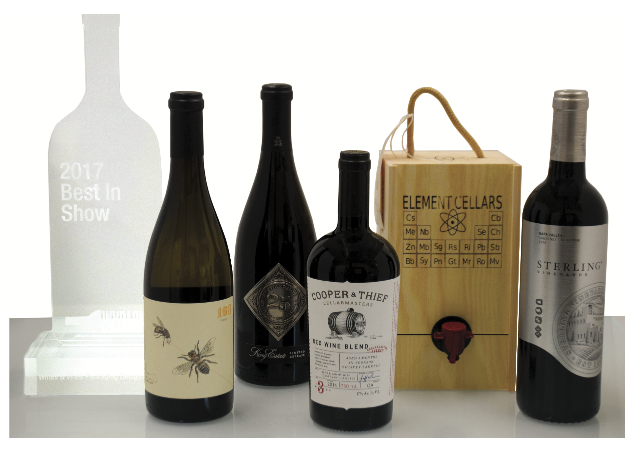
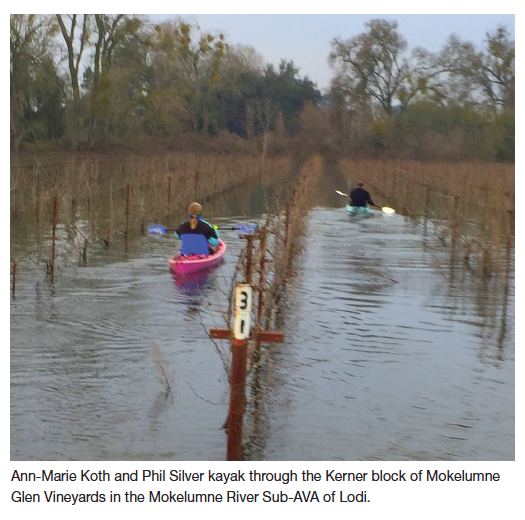
.png)
